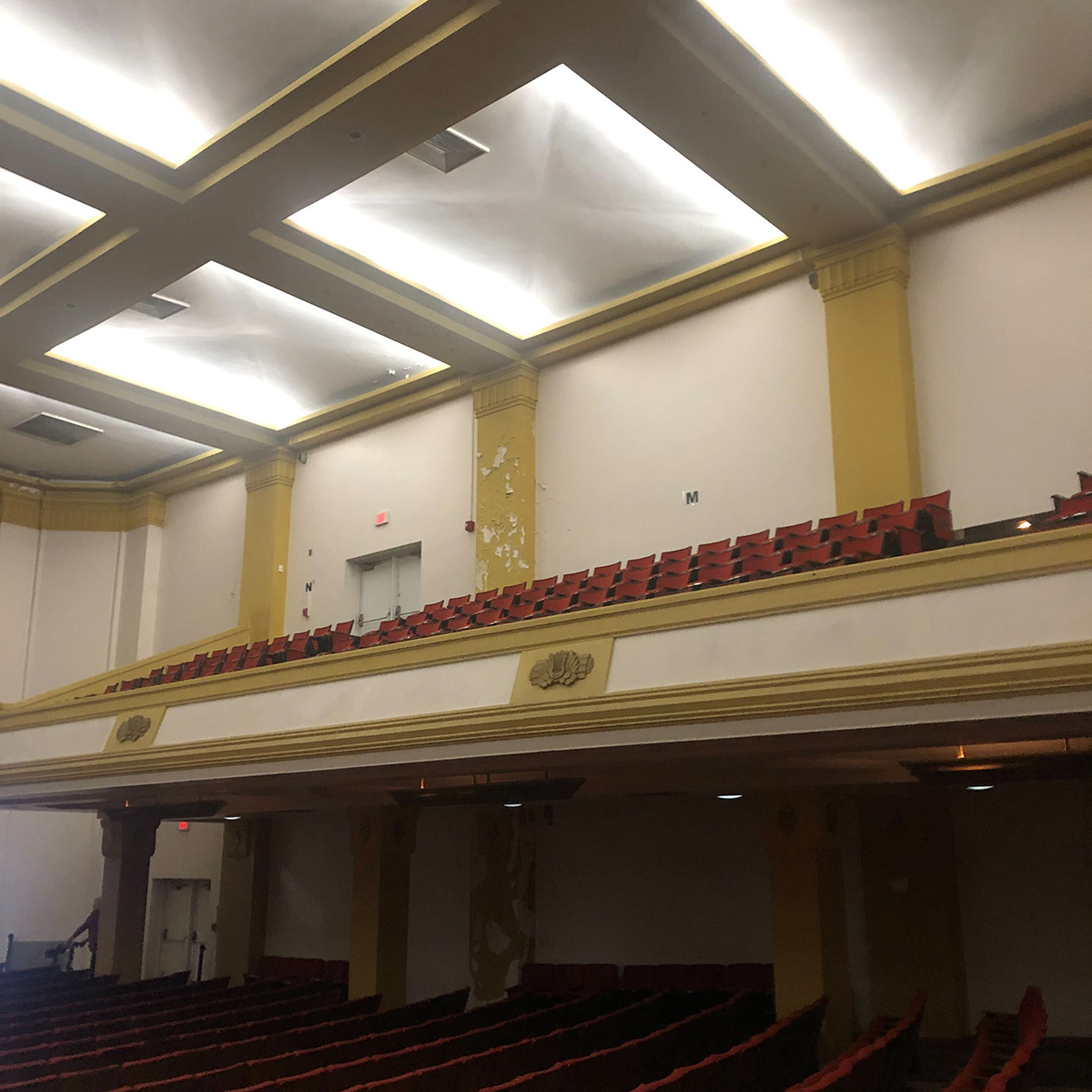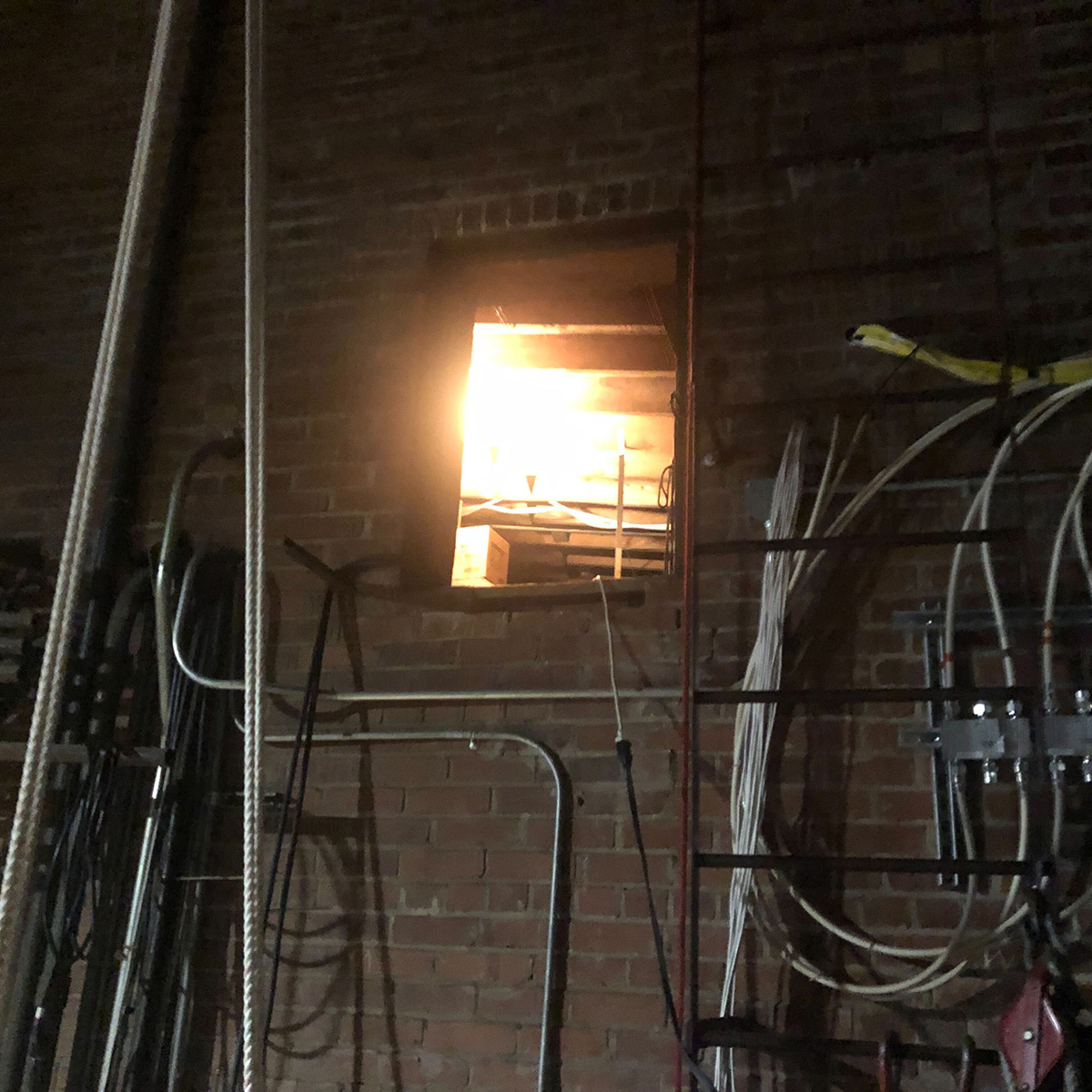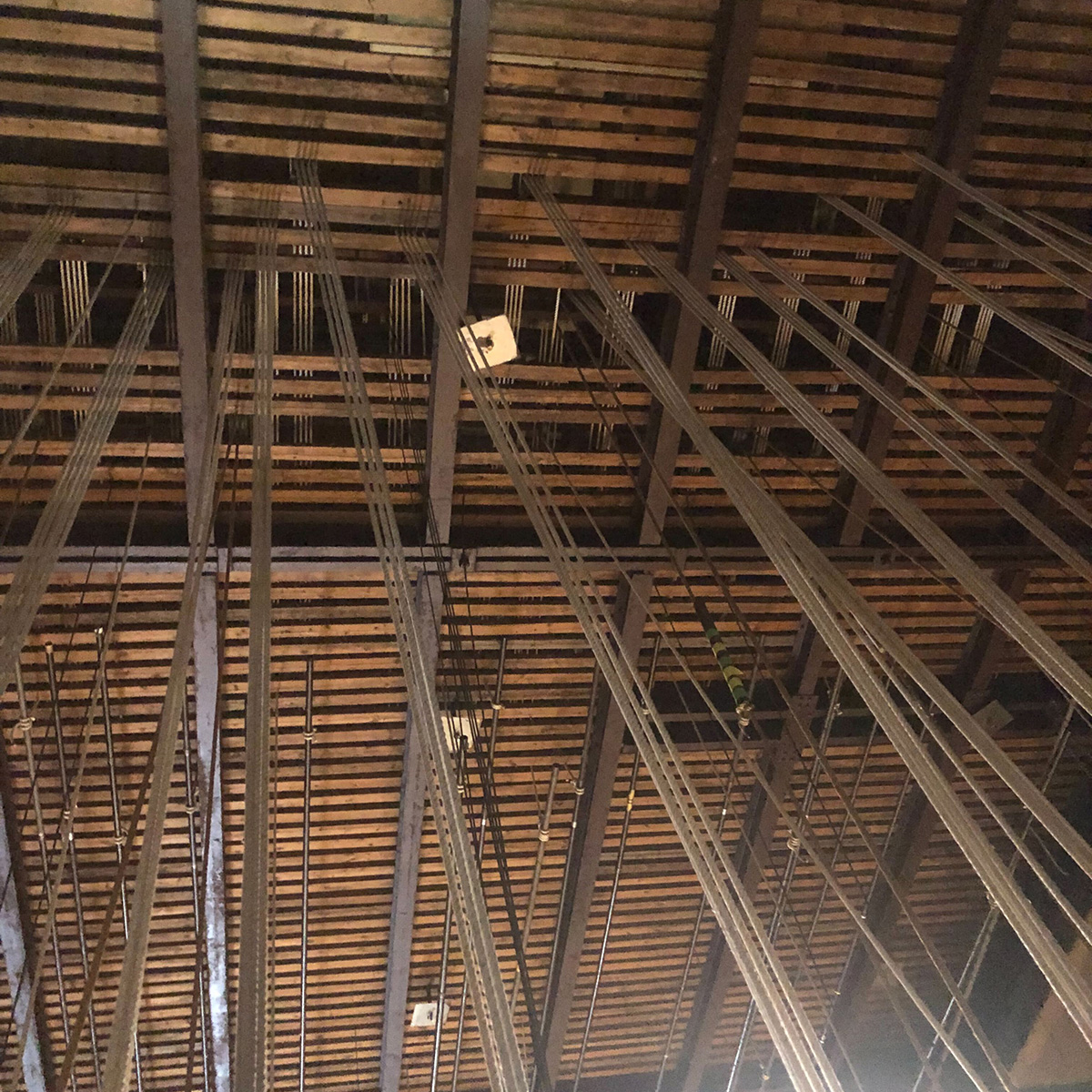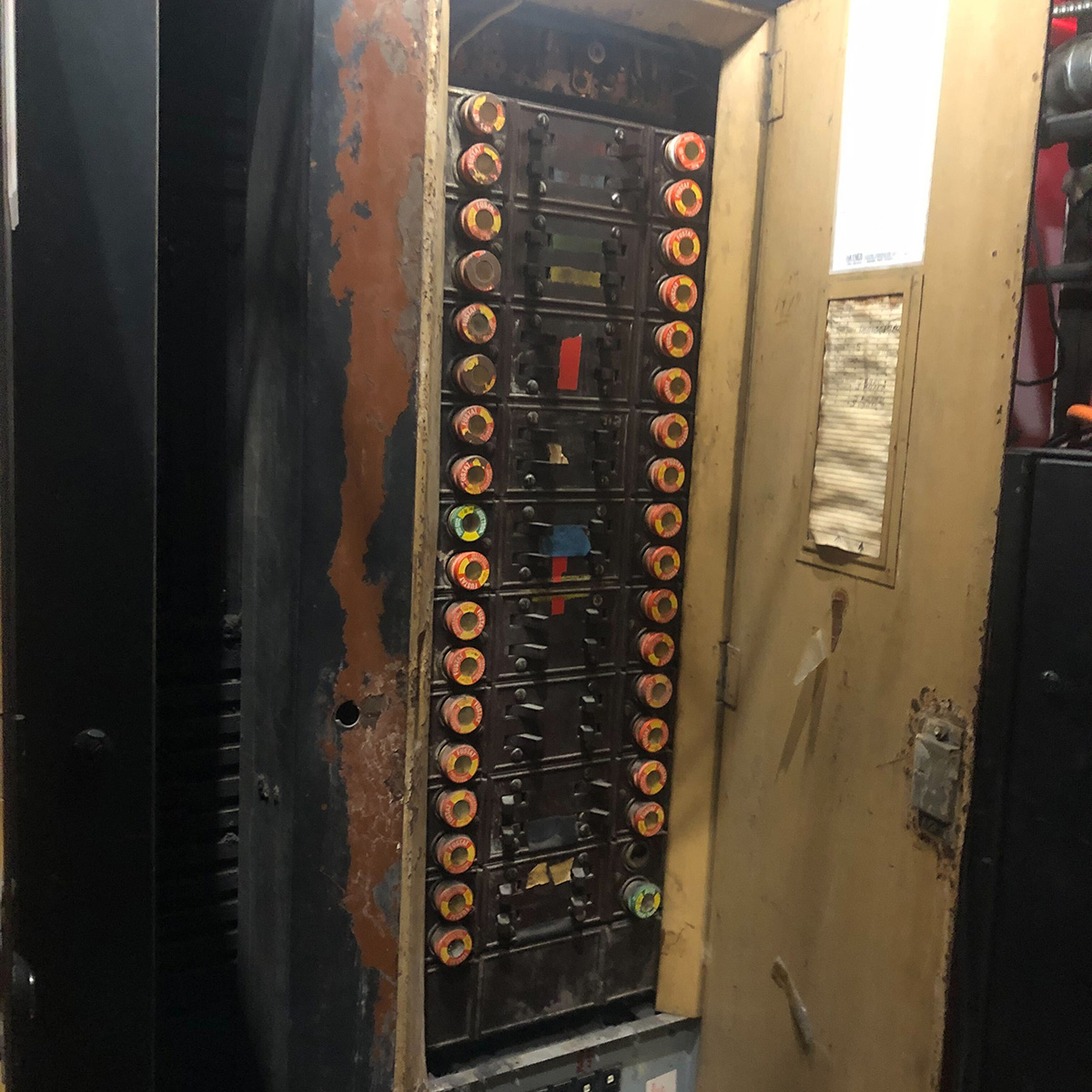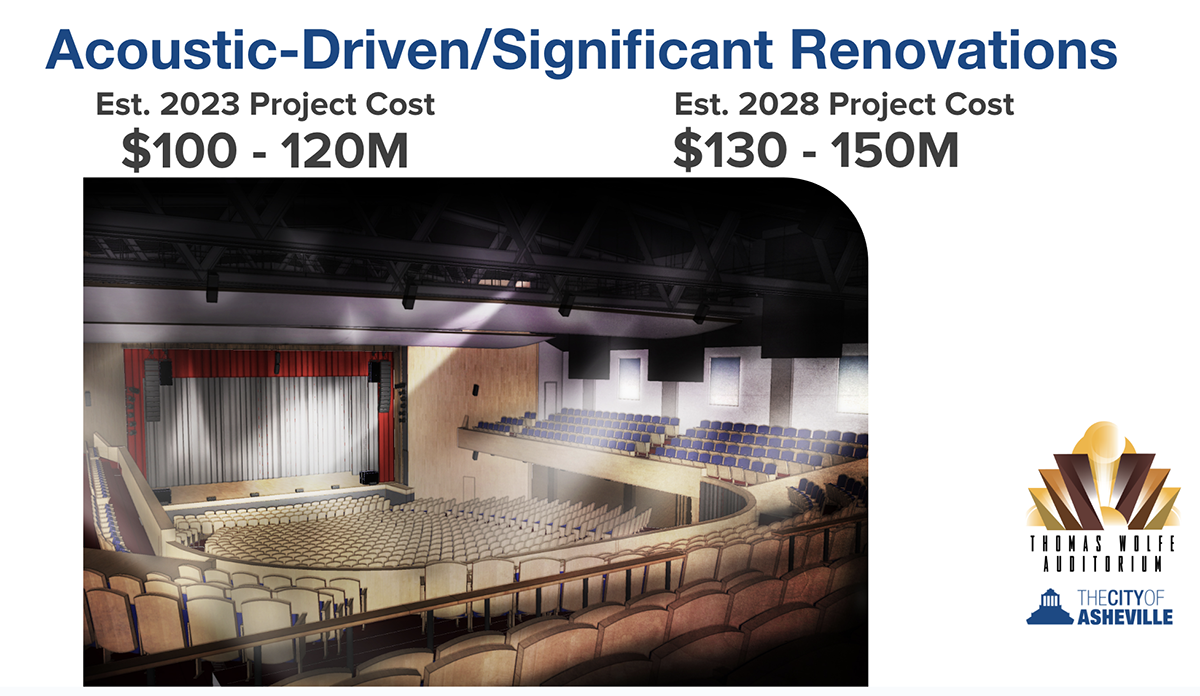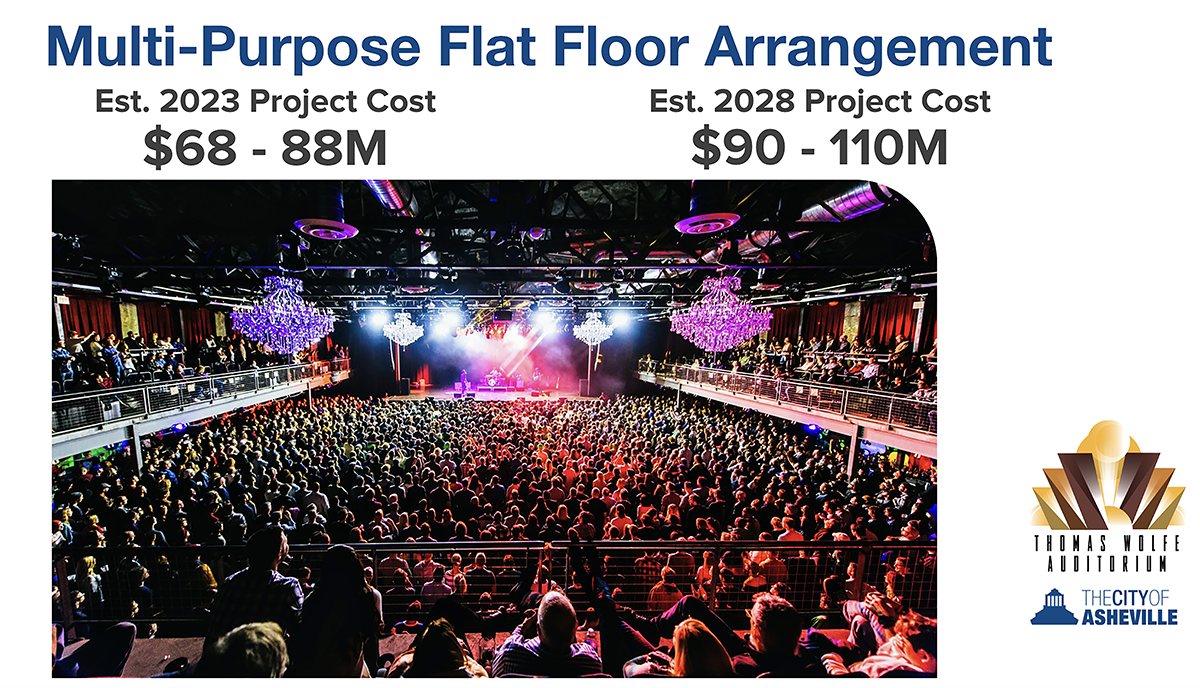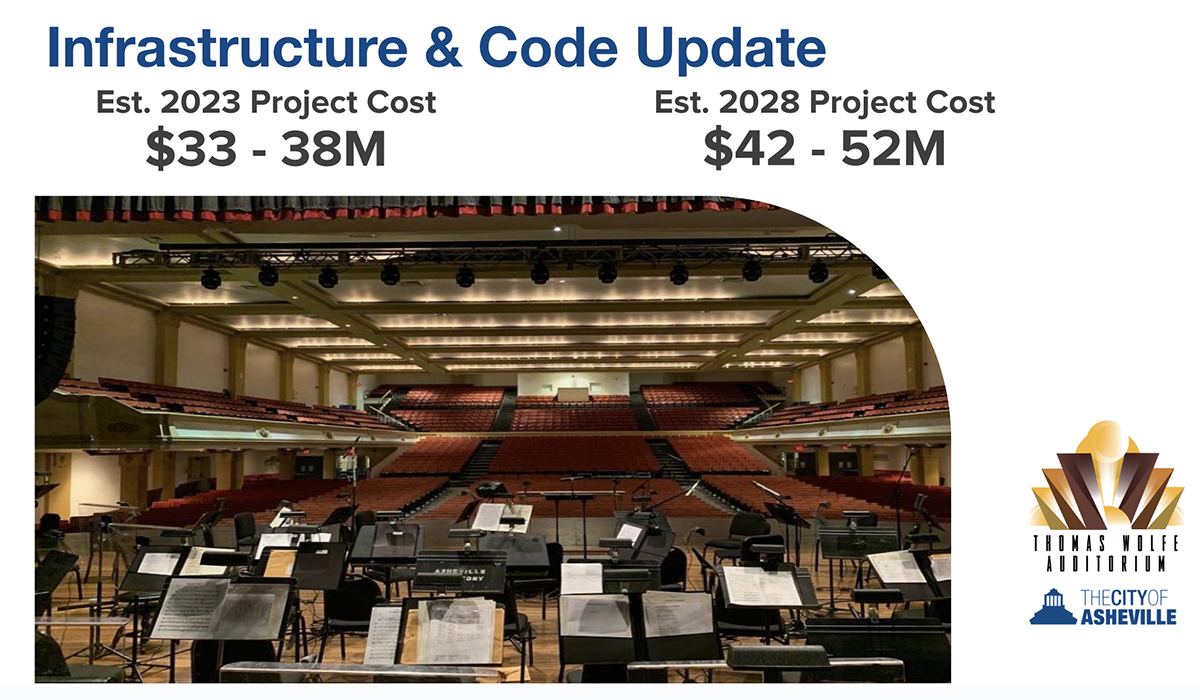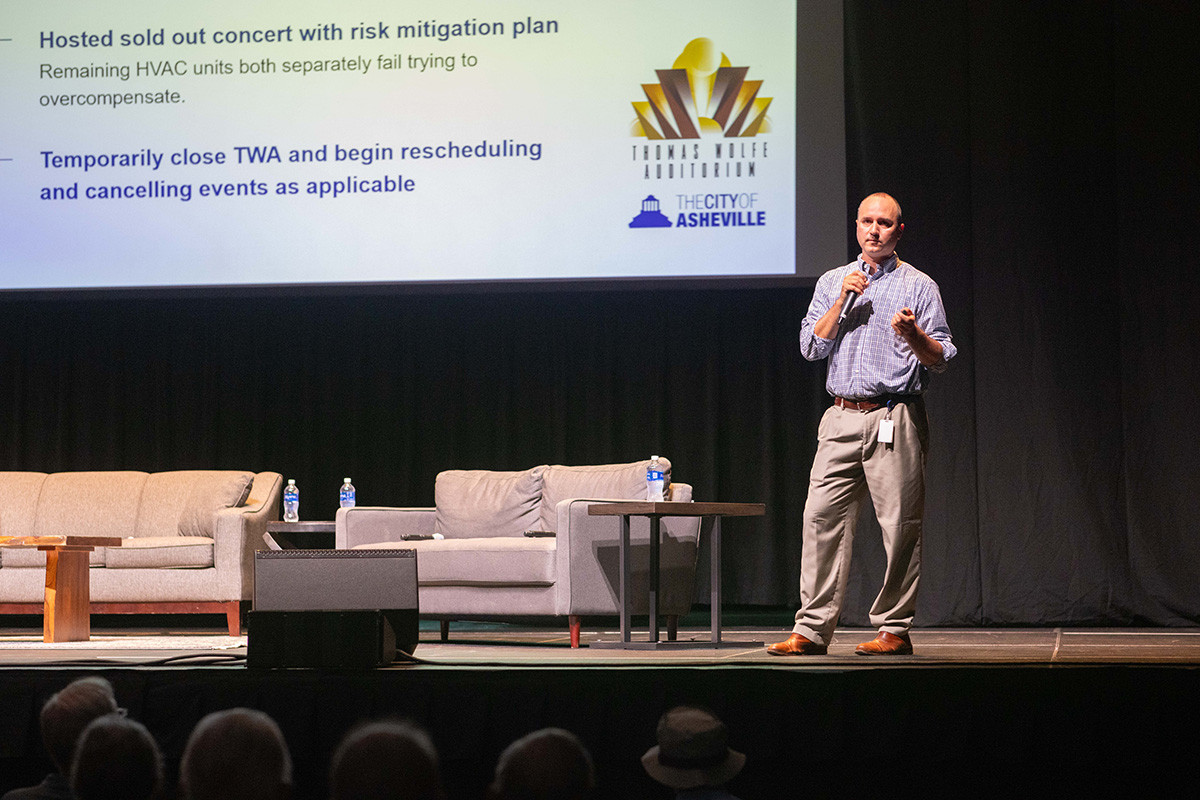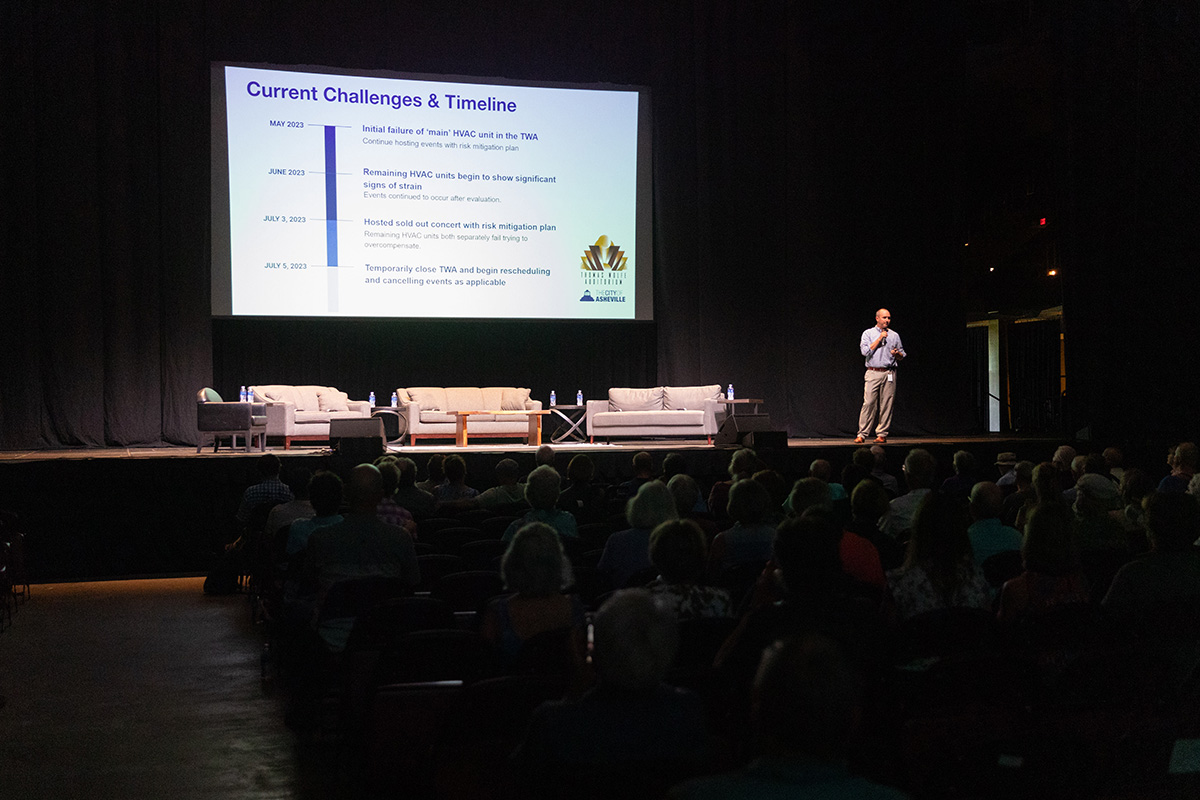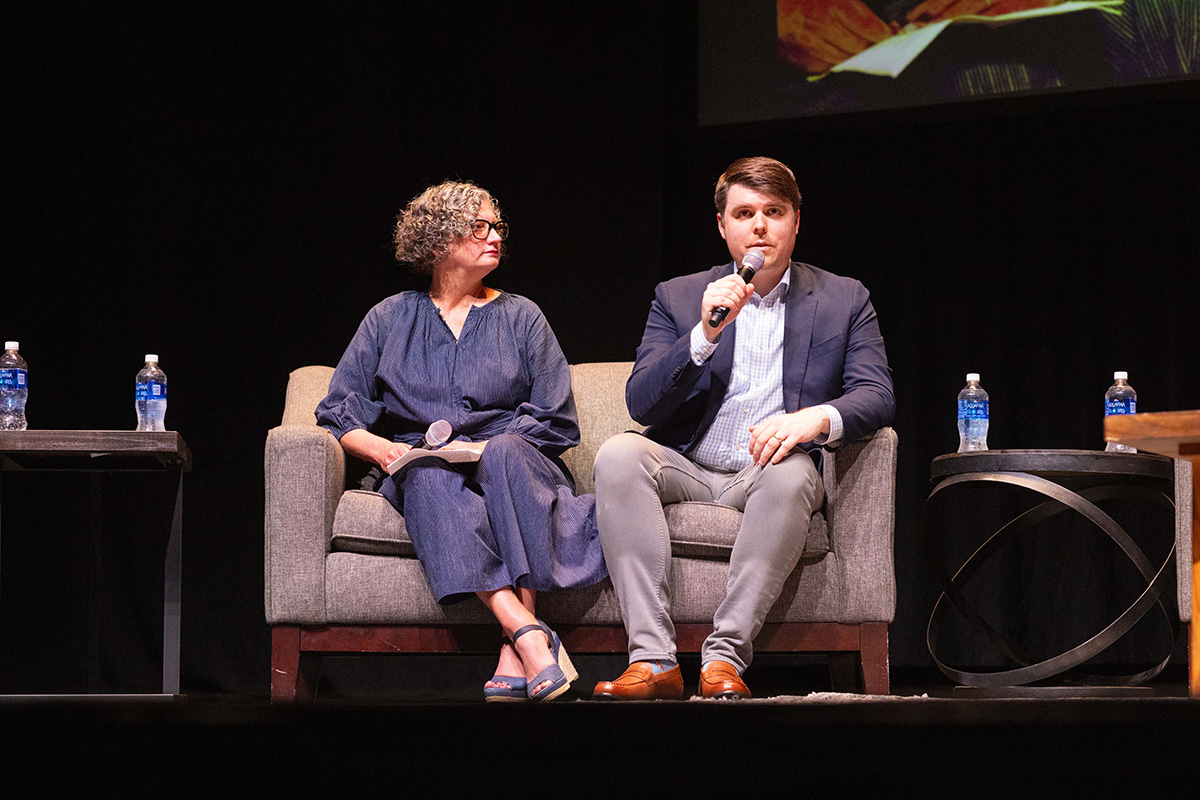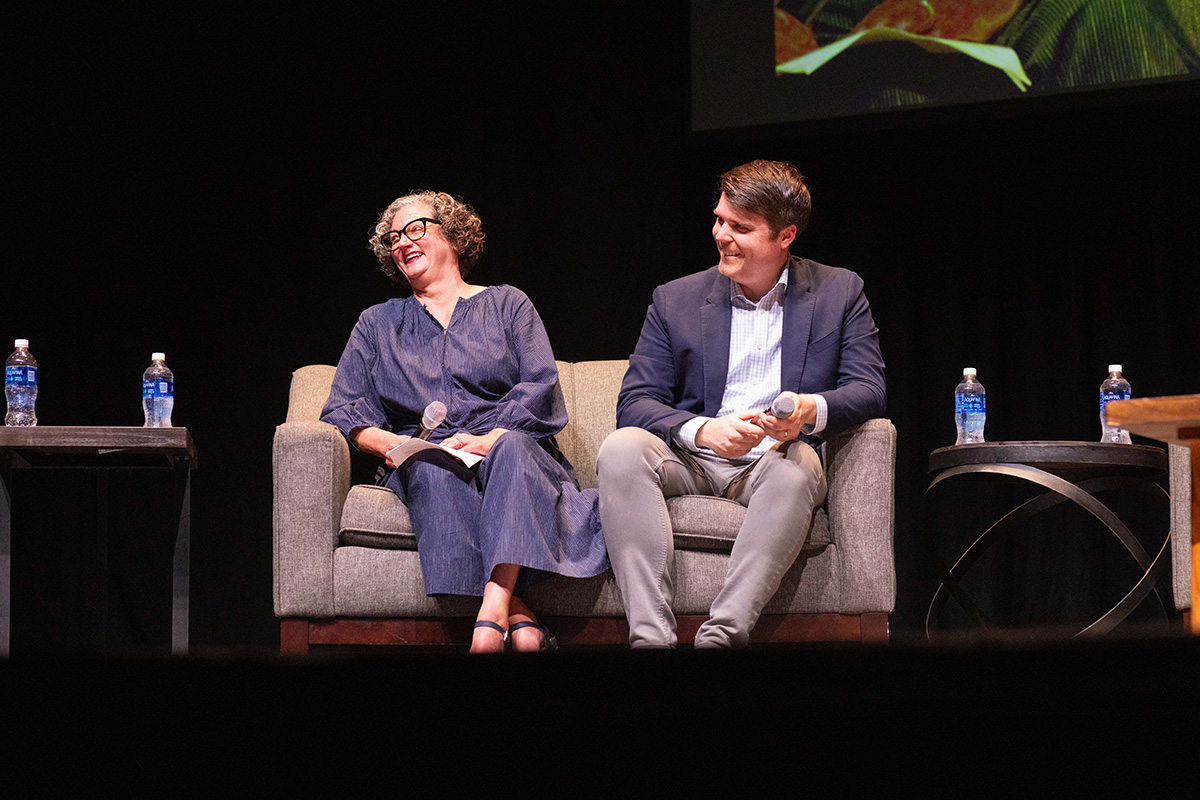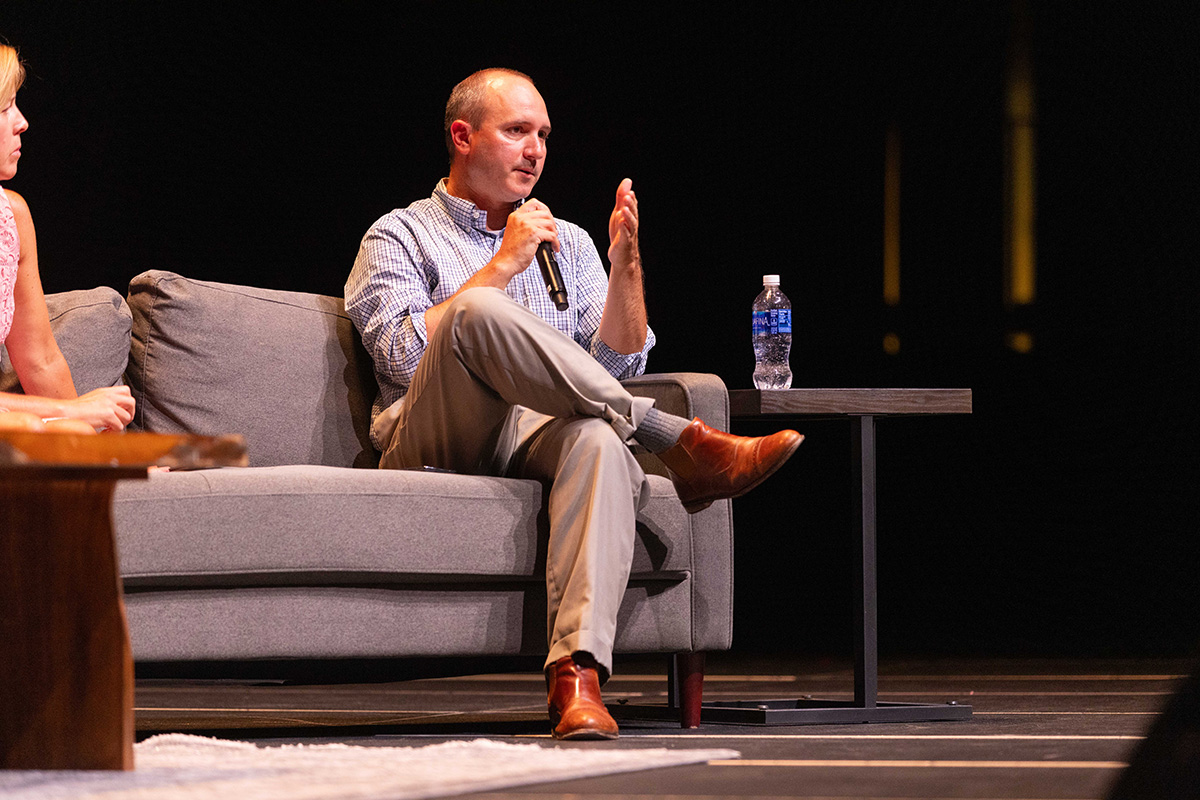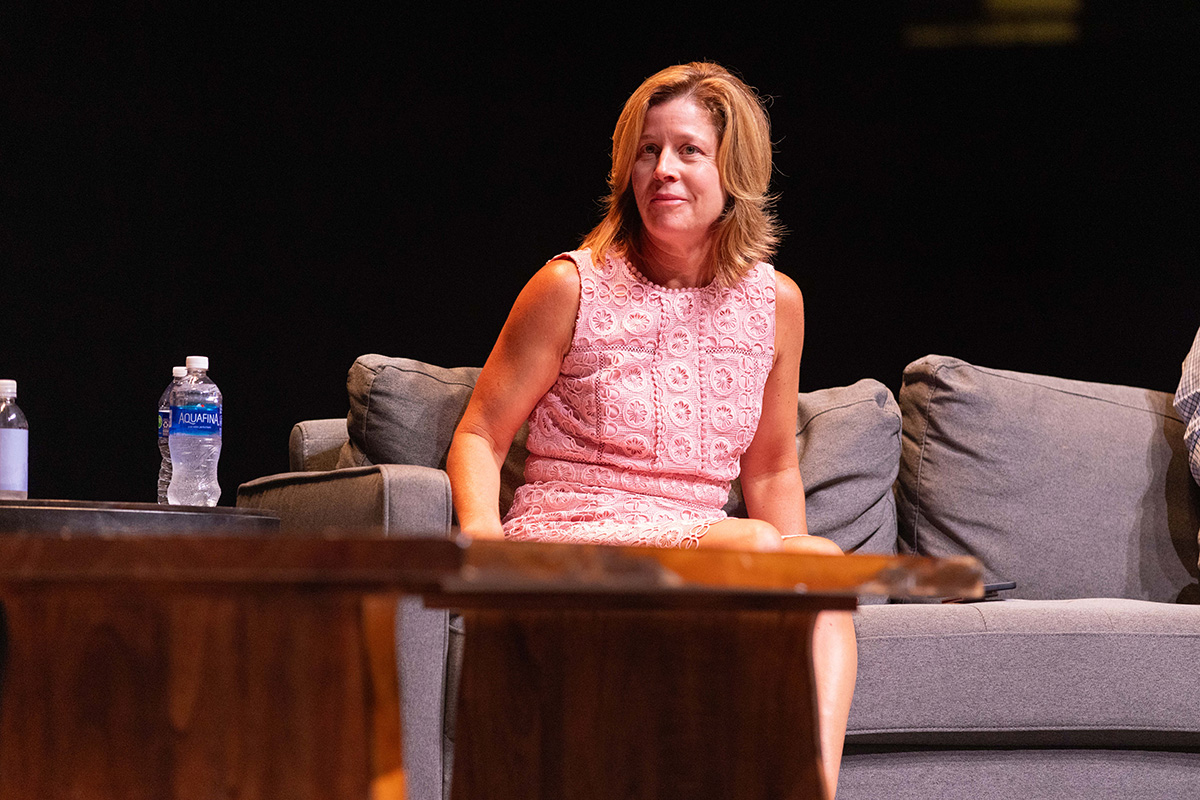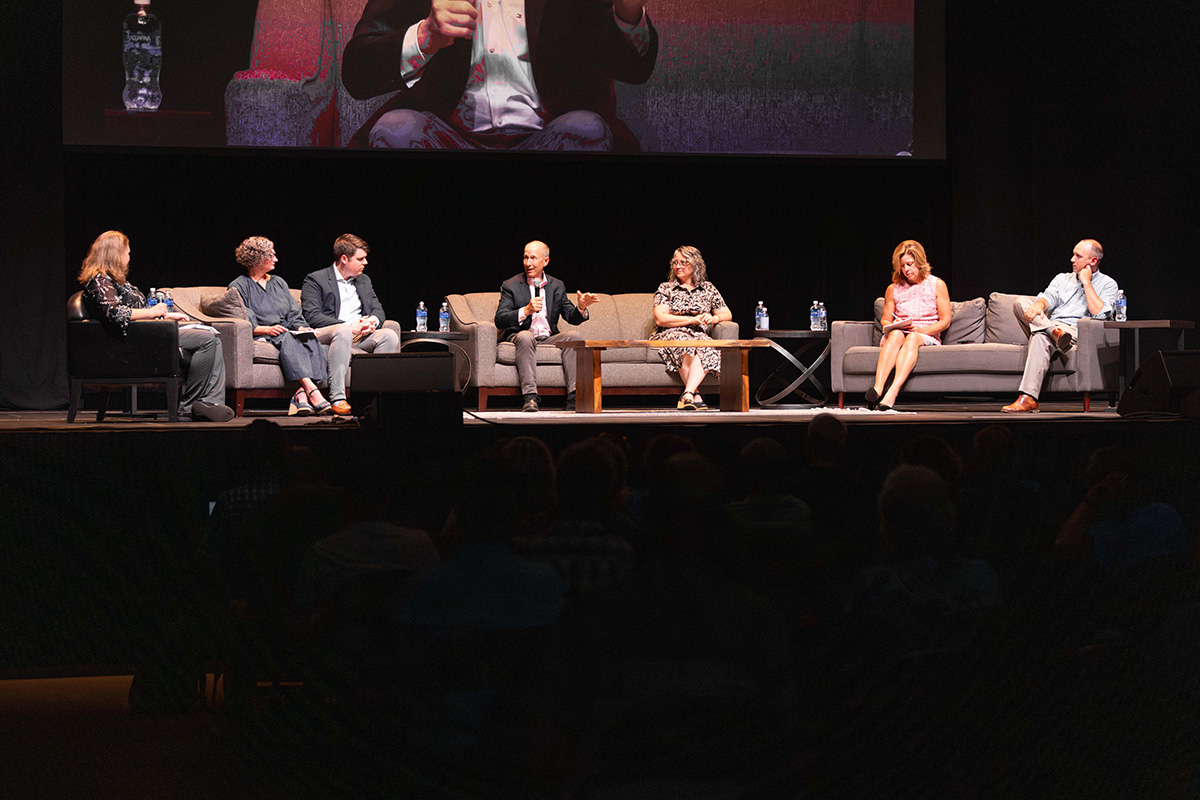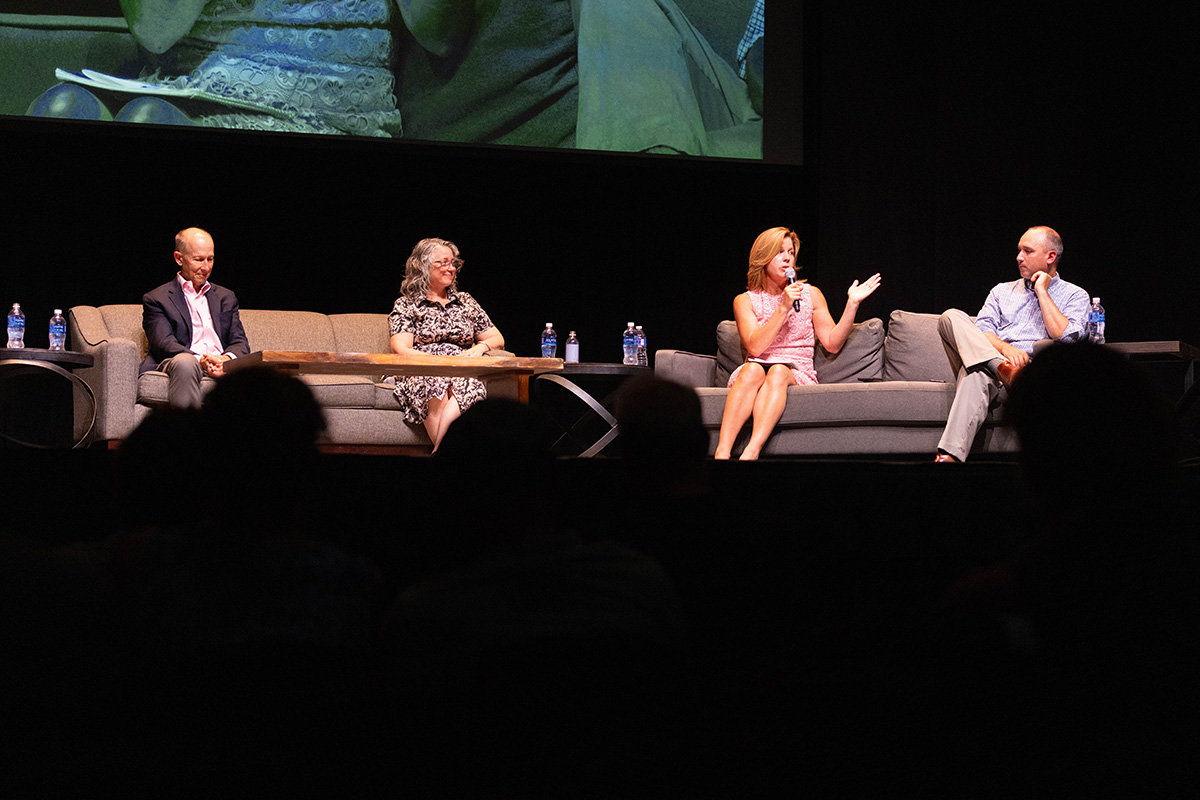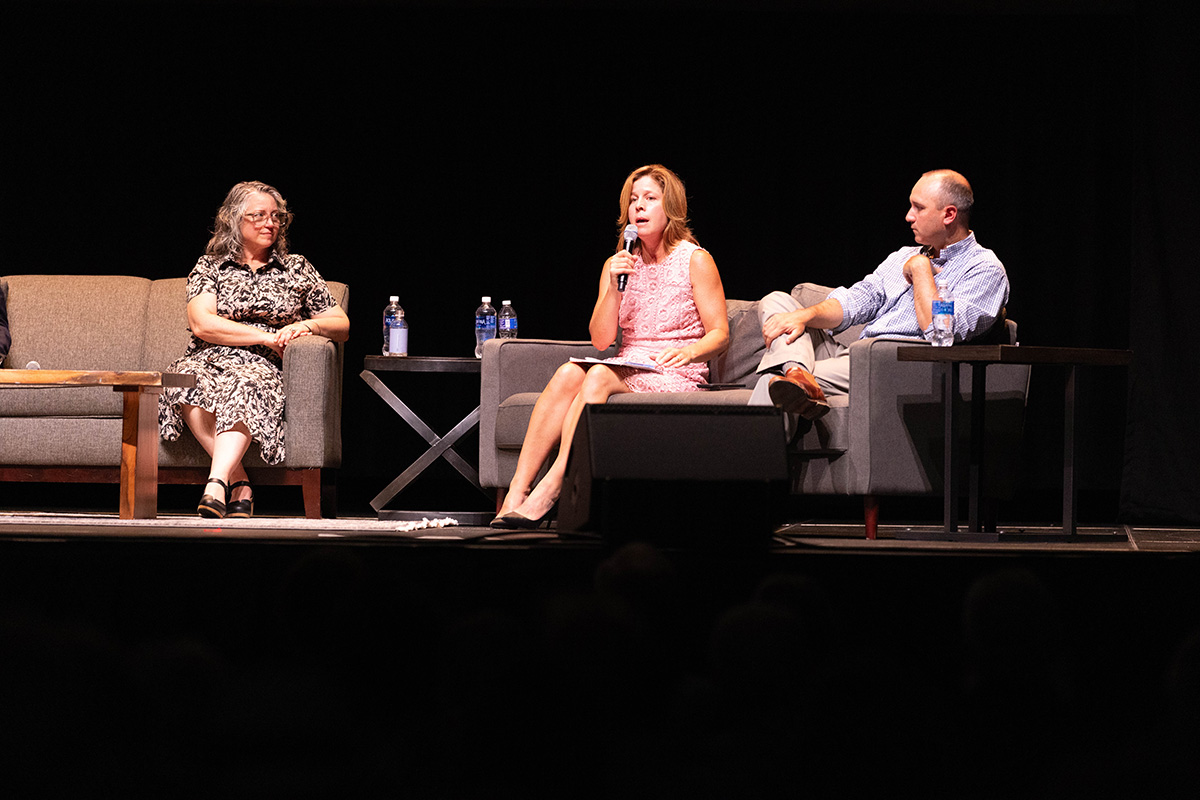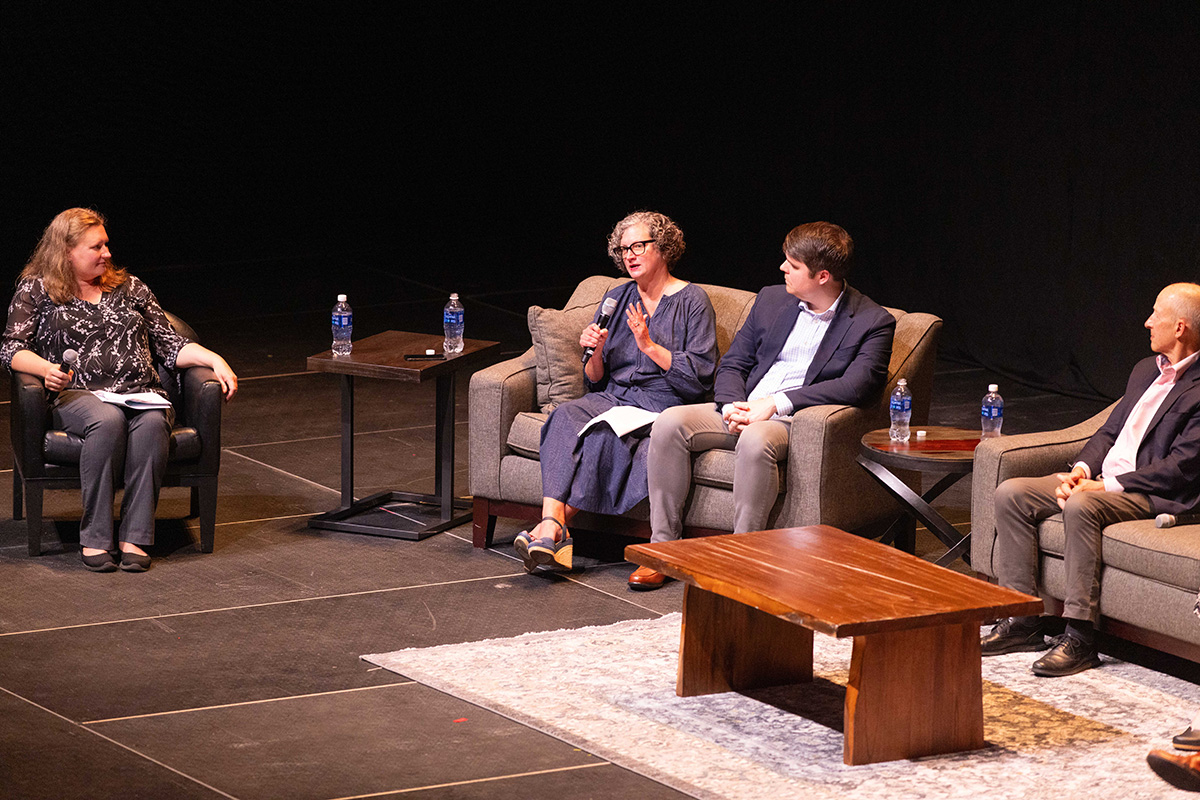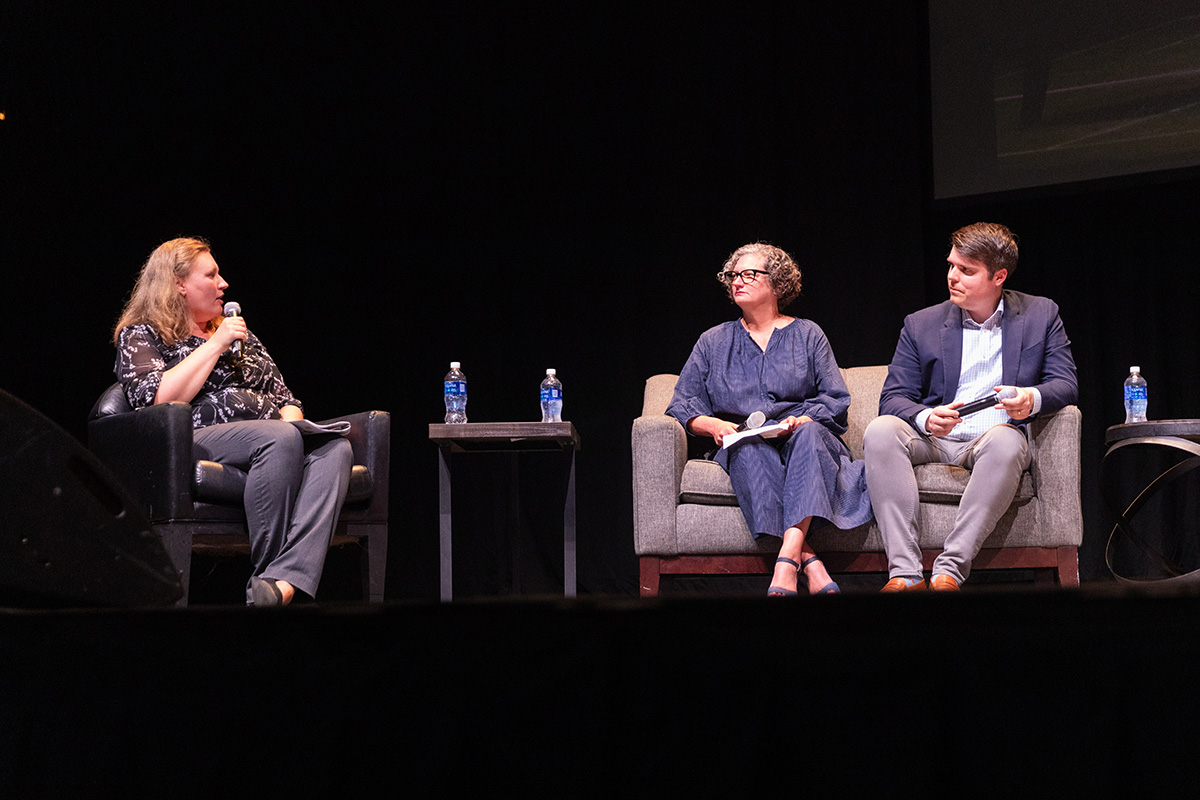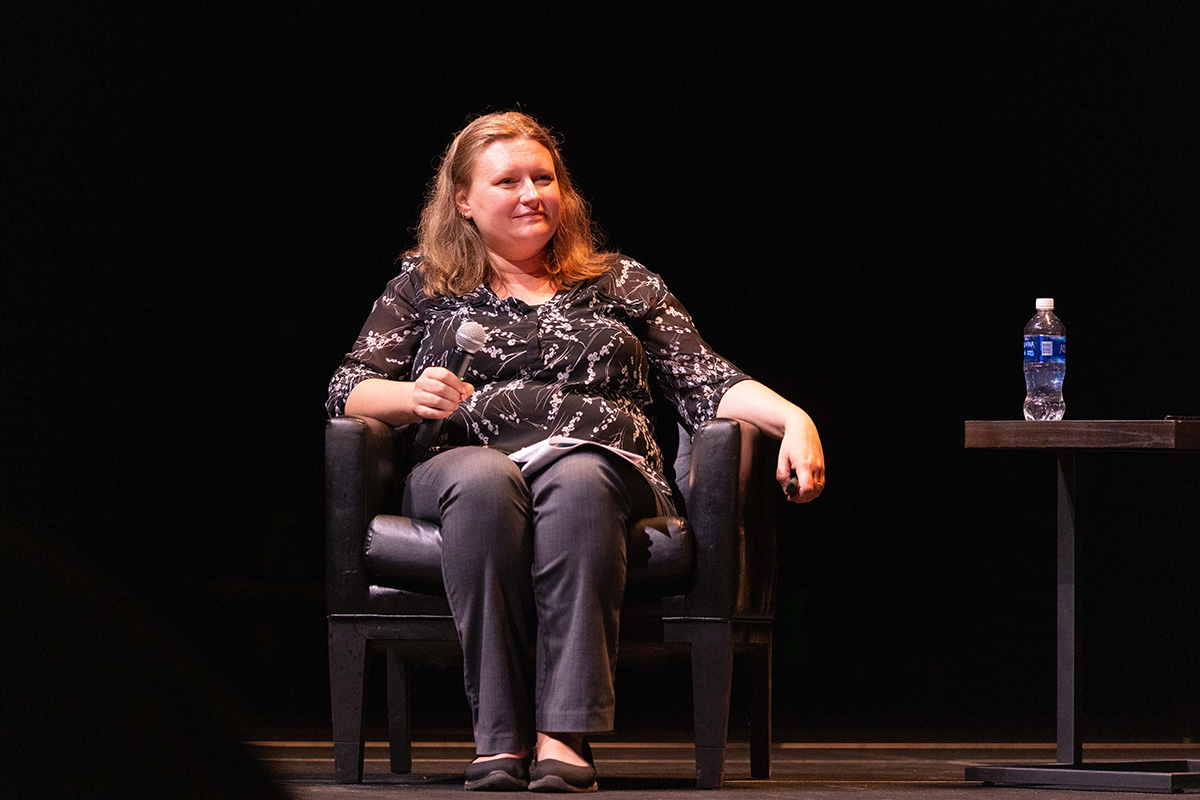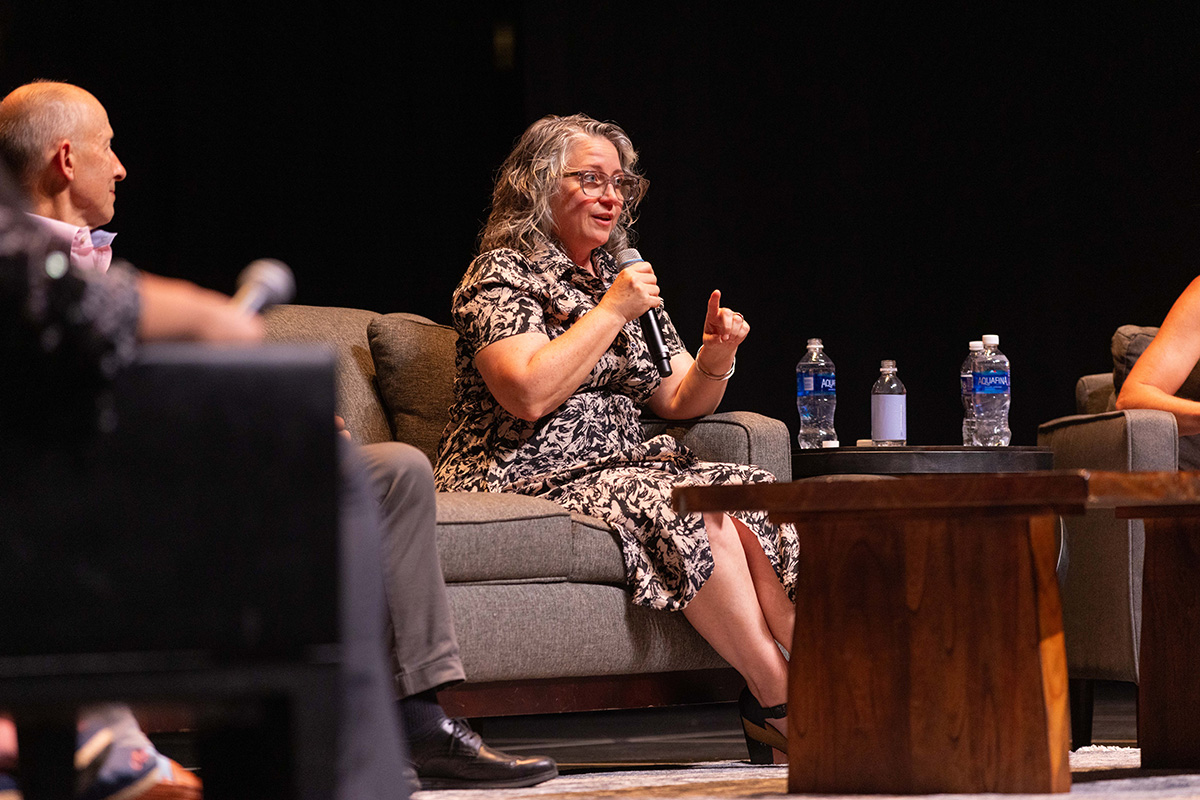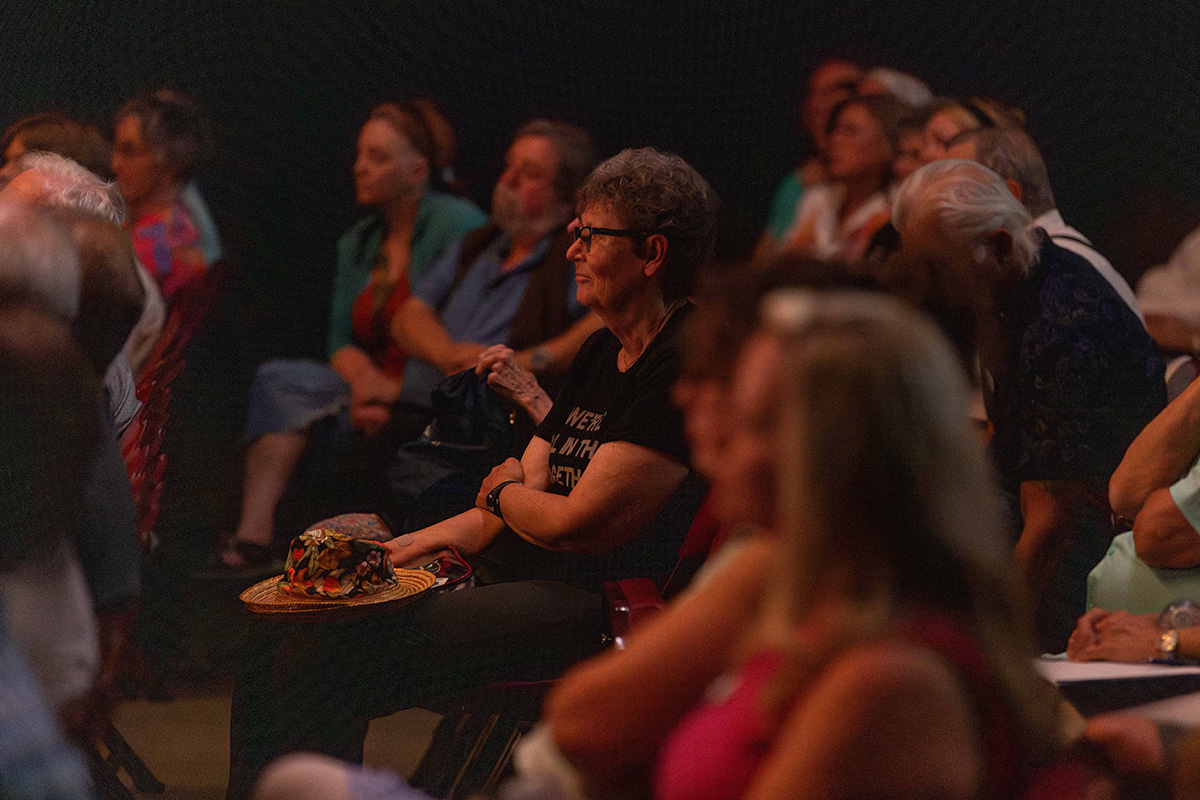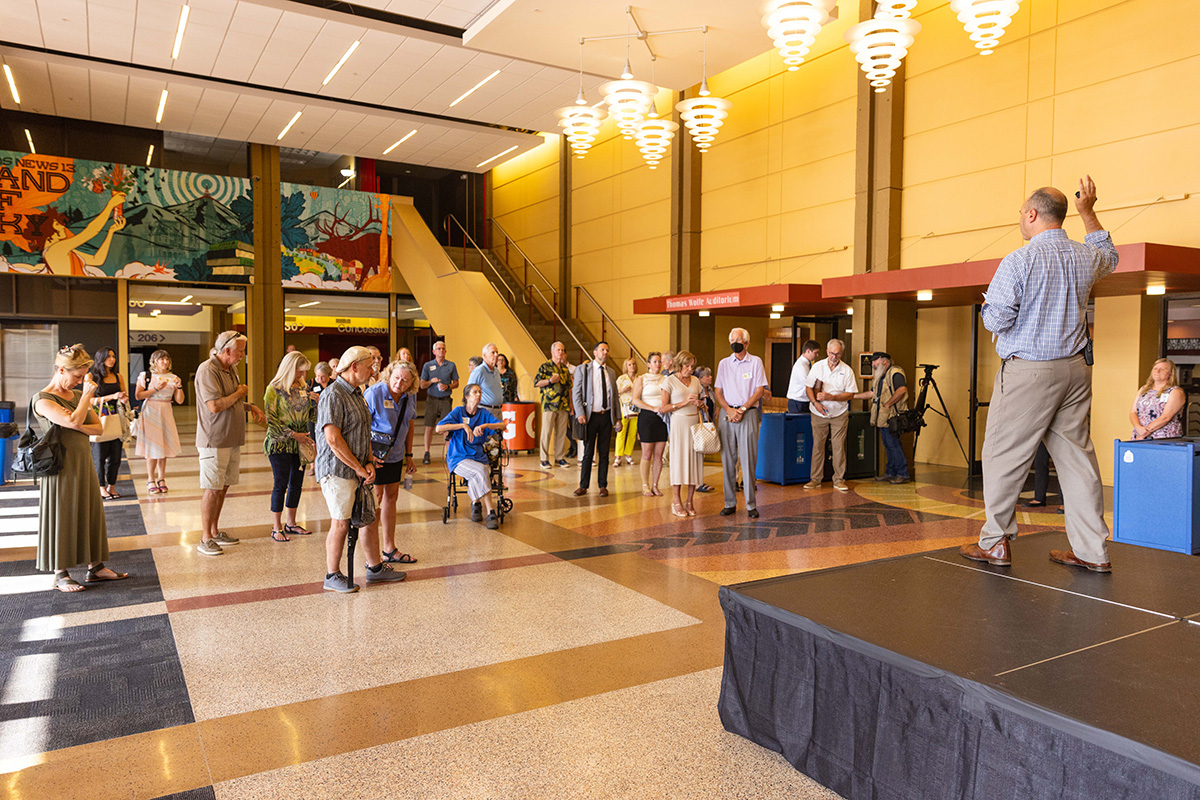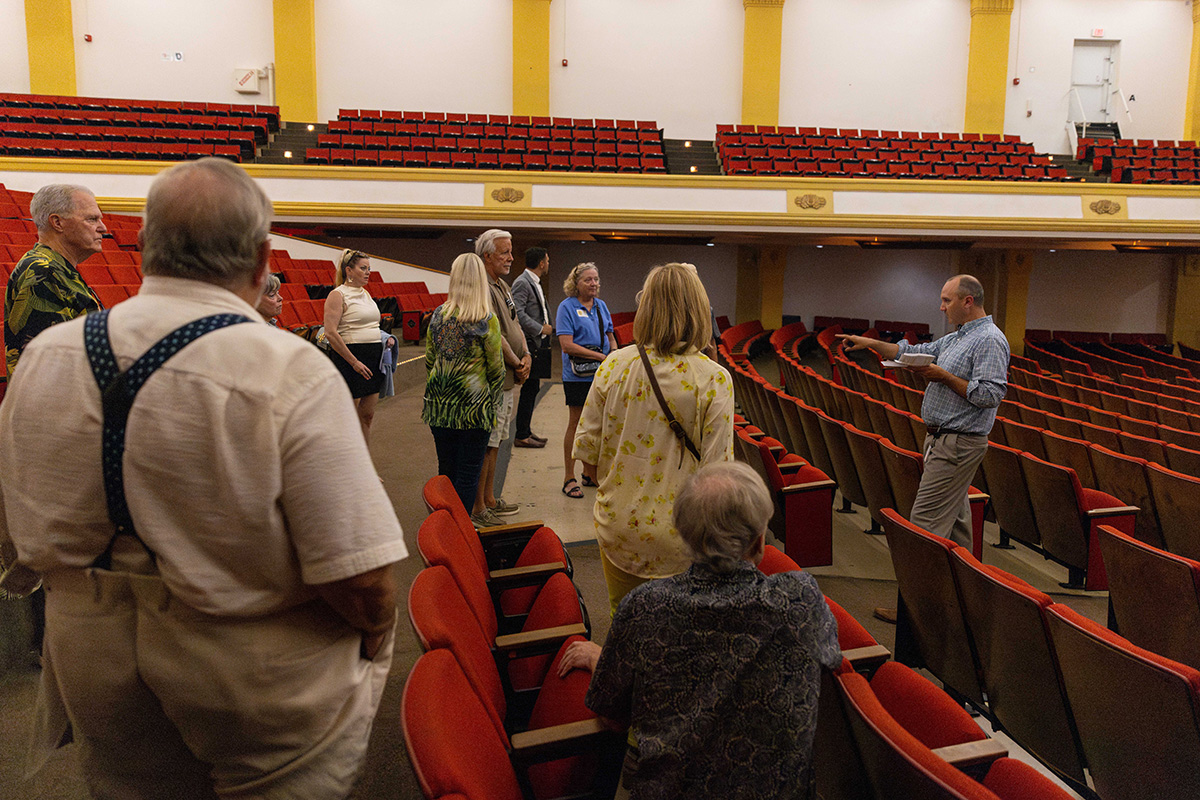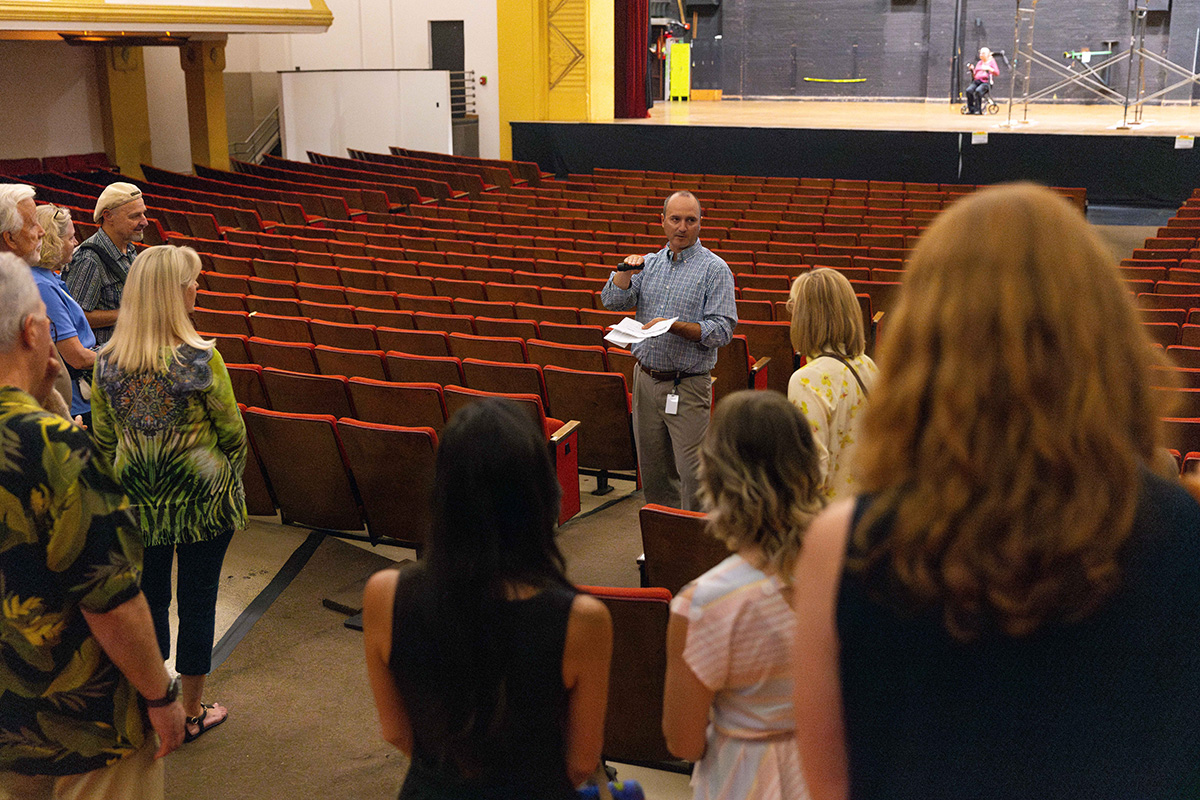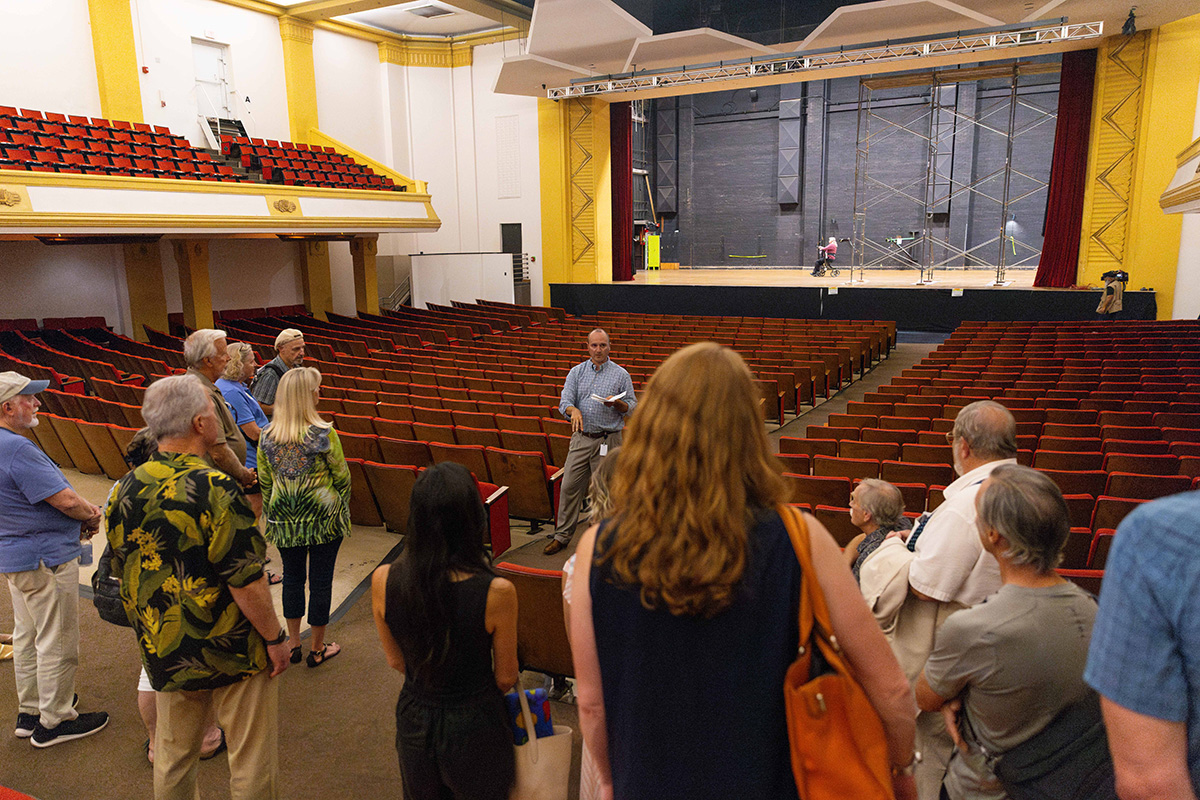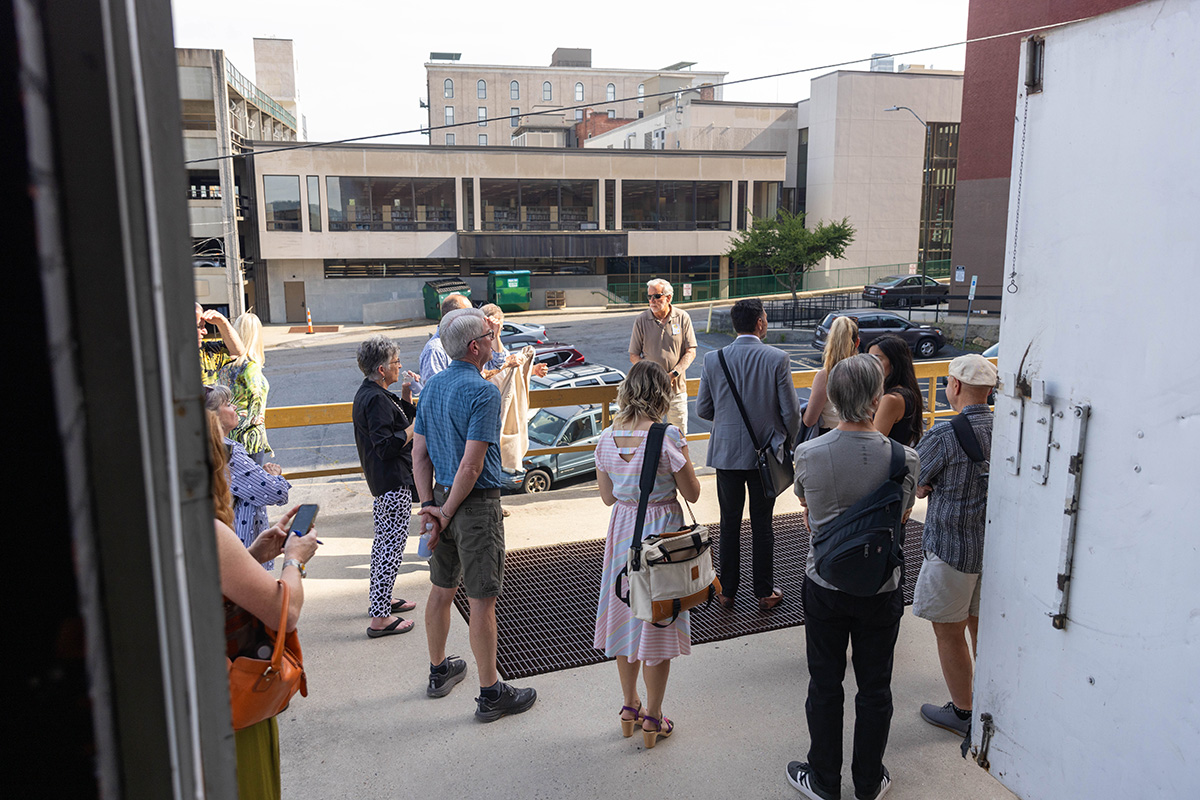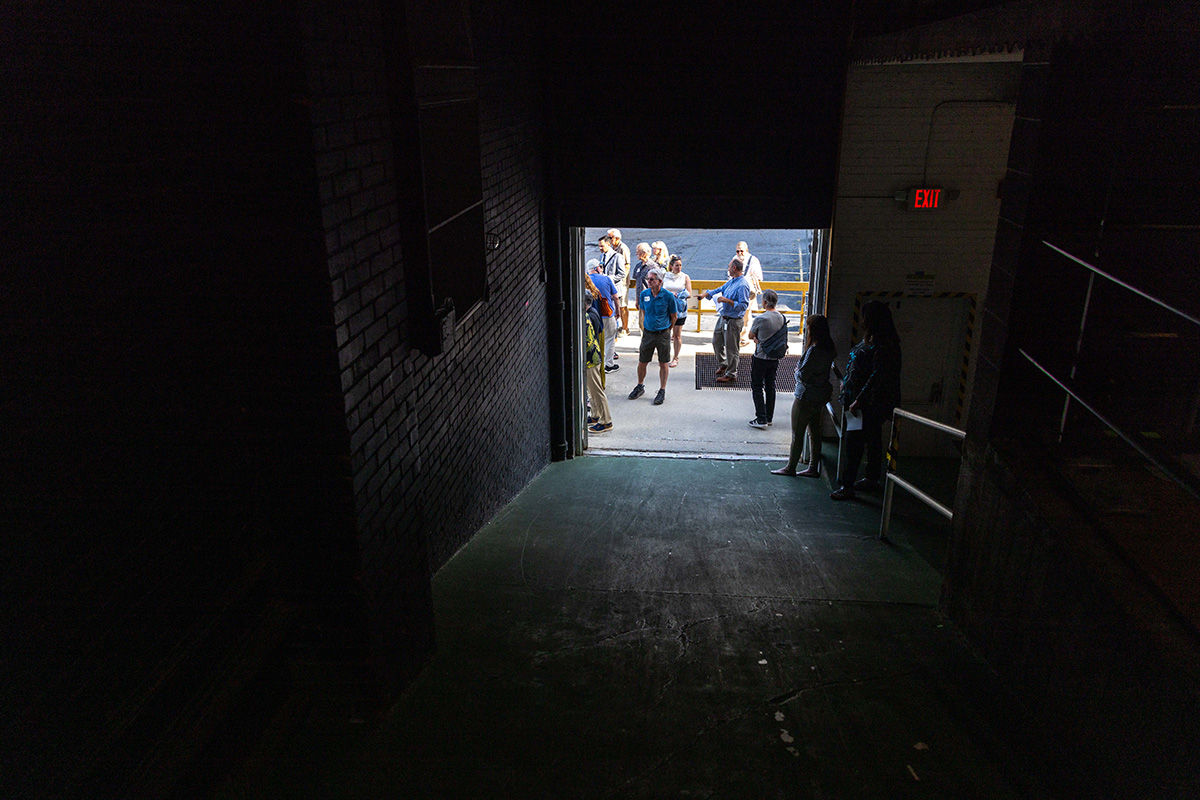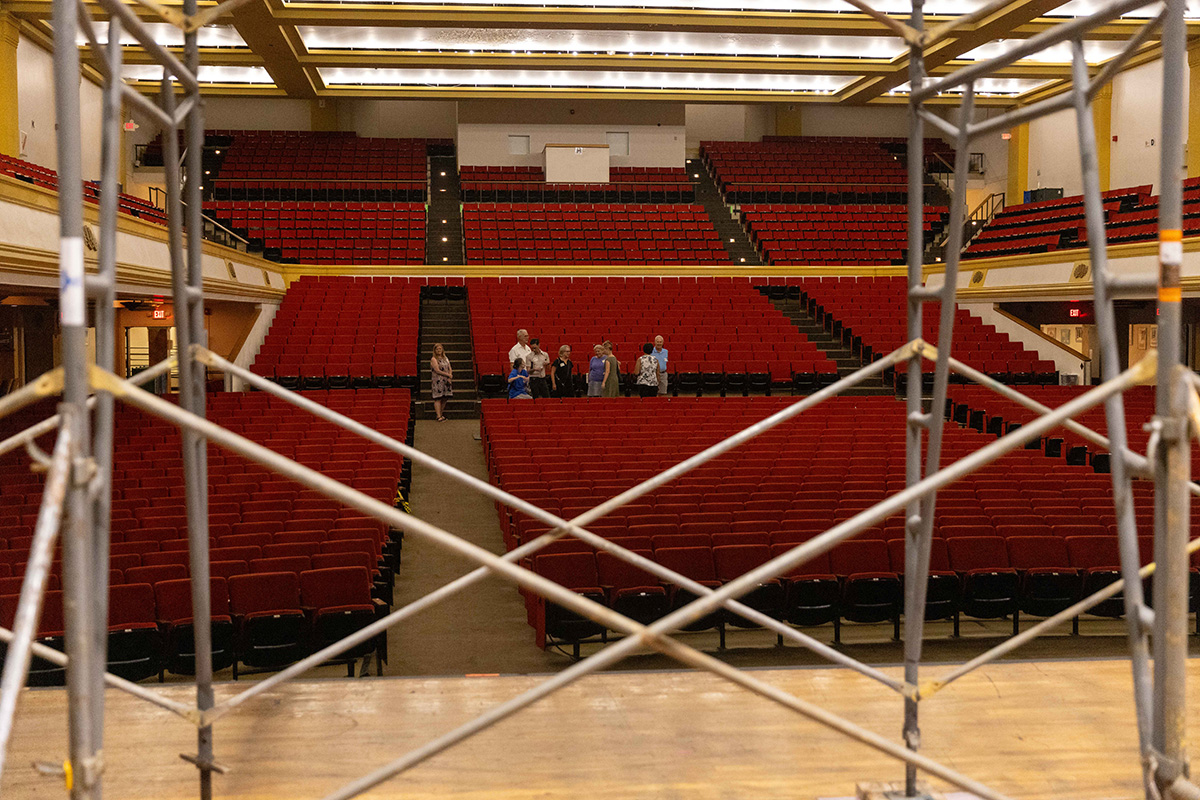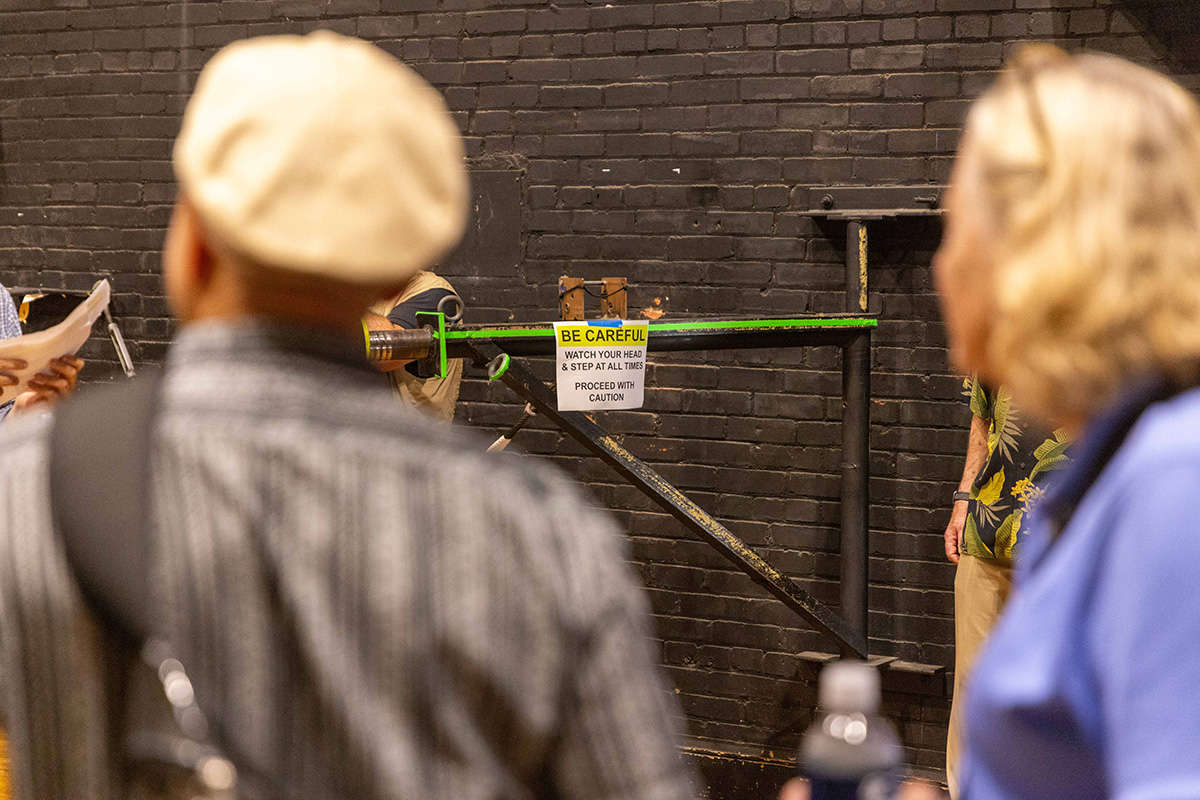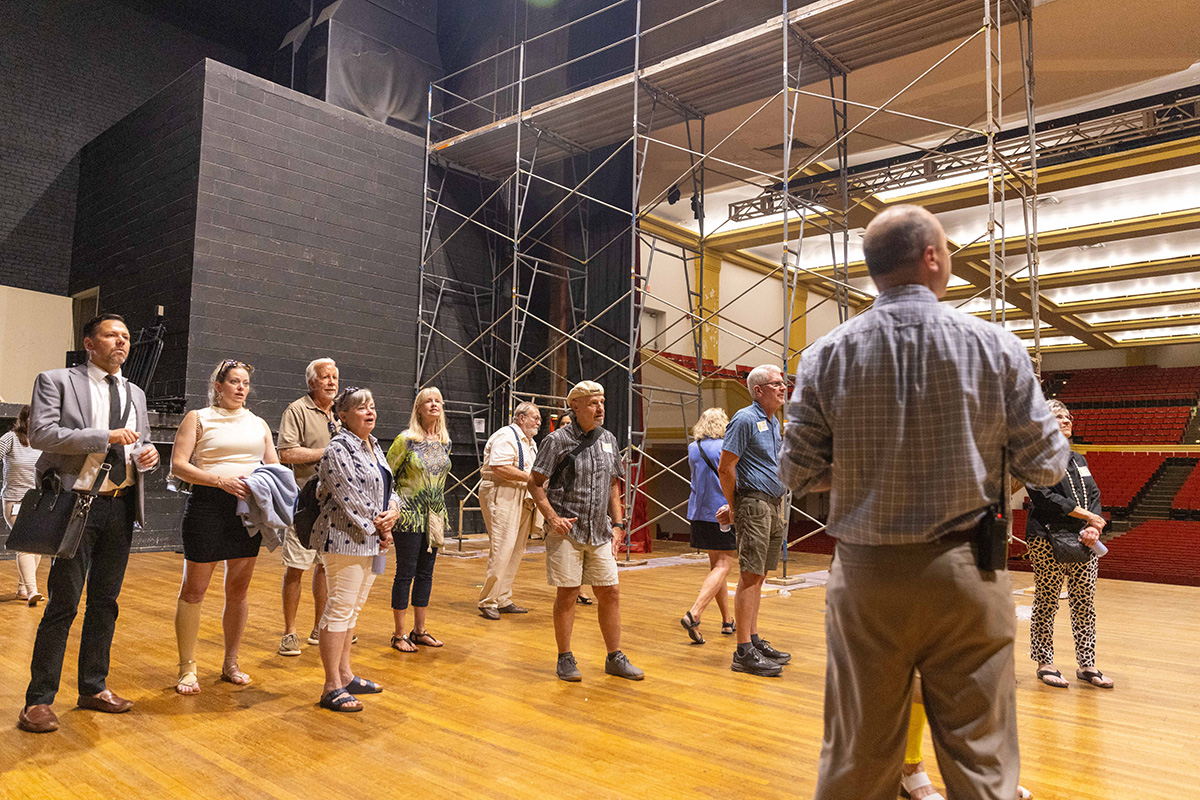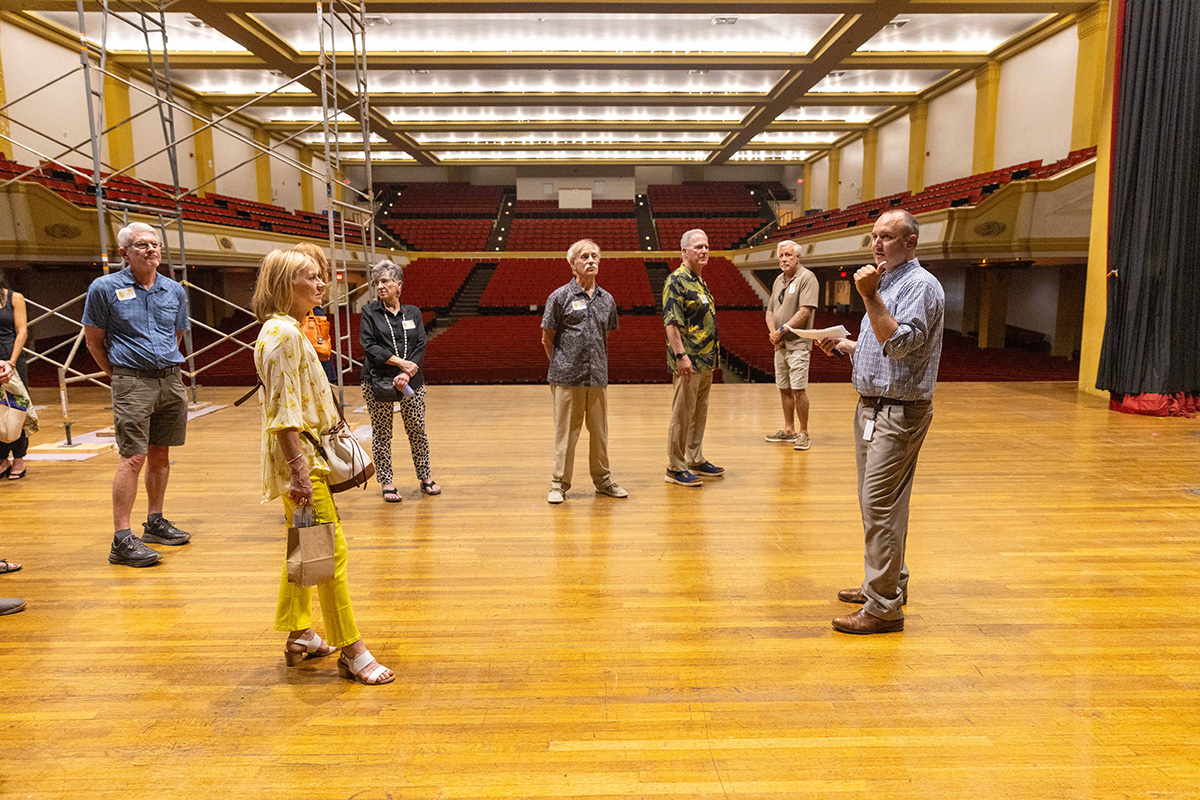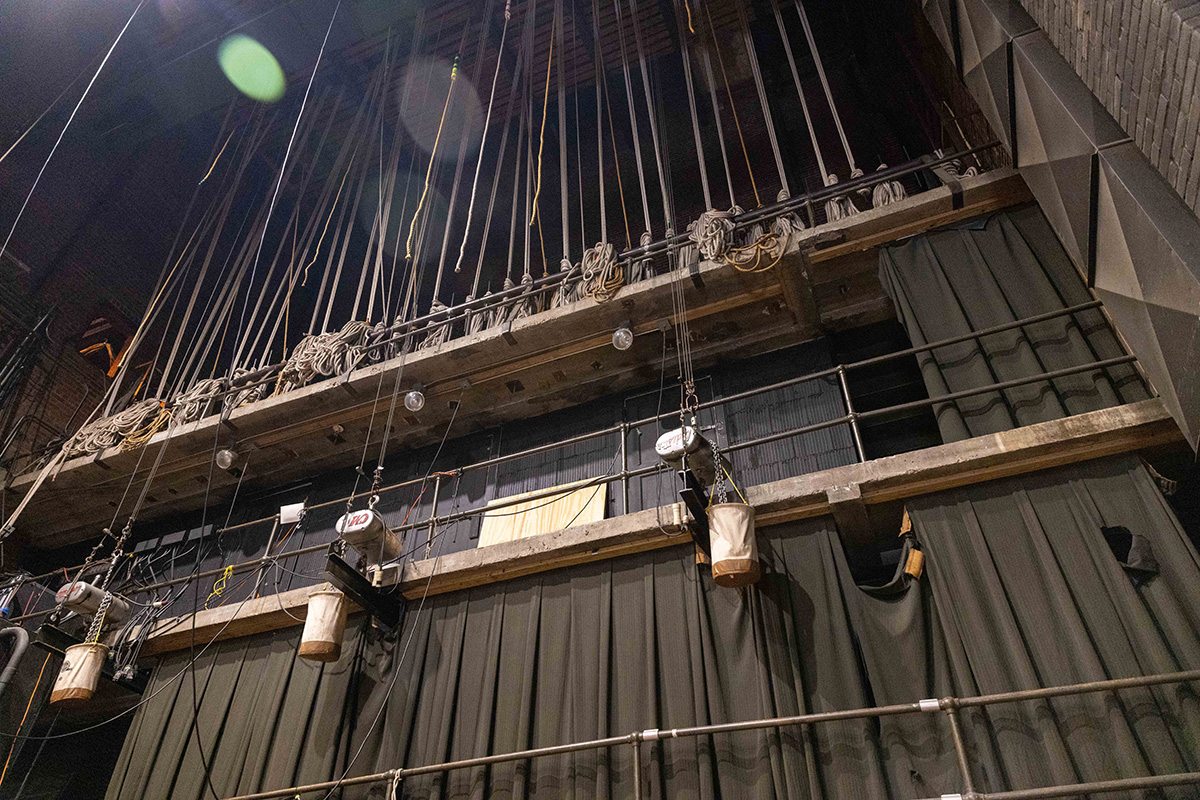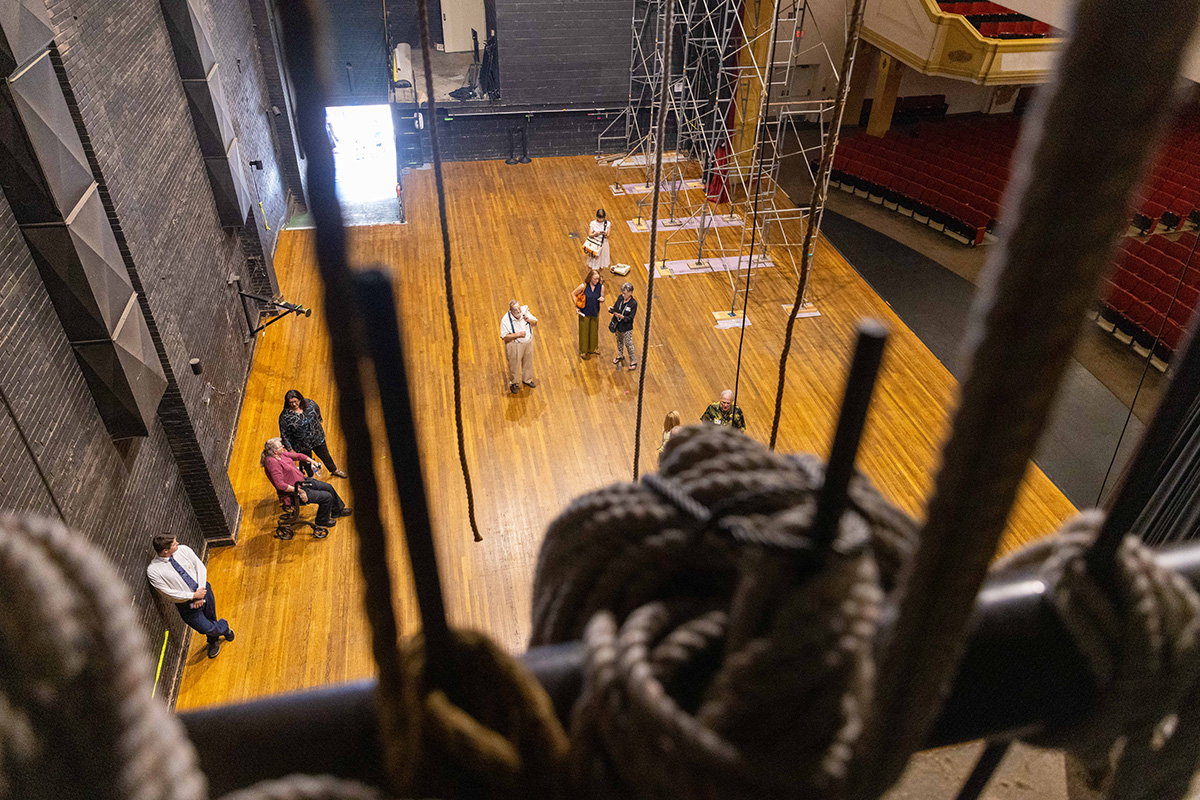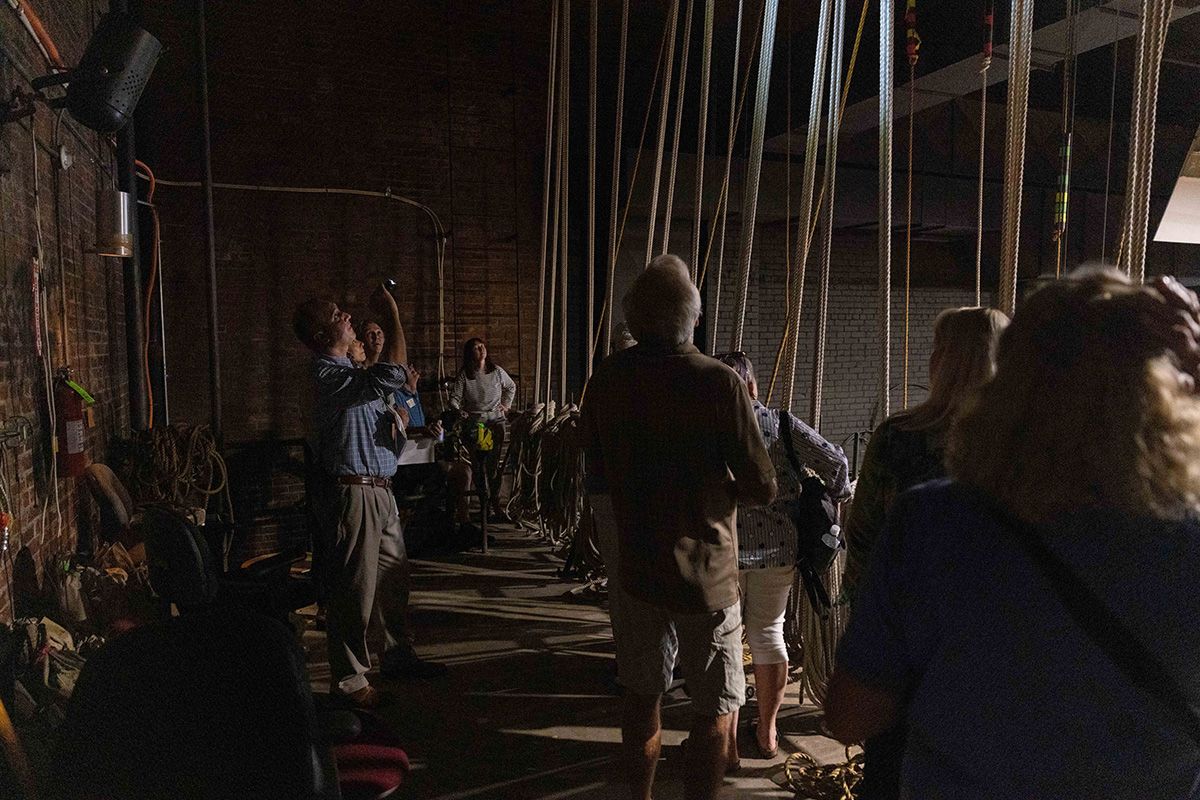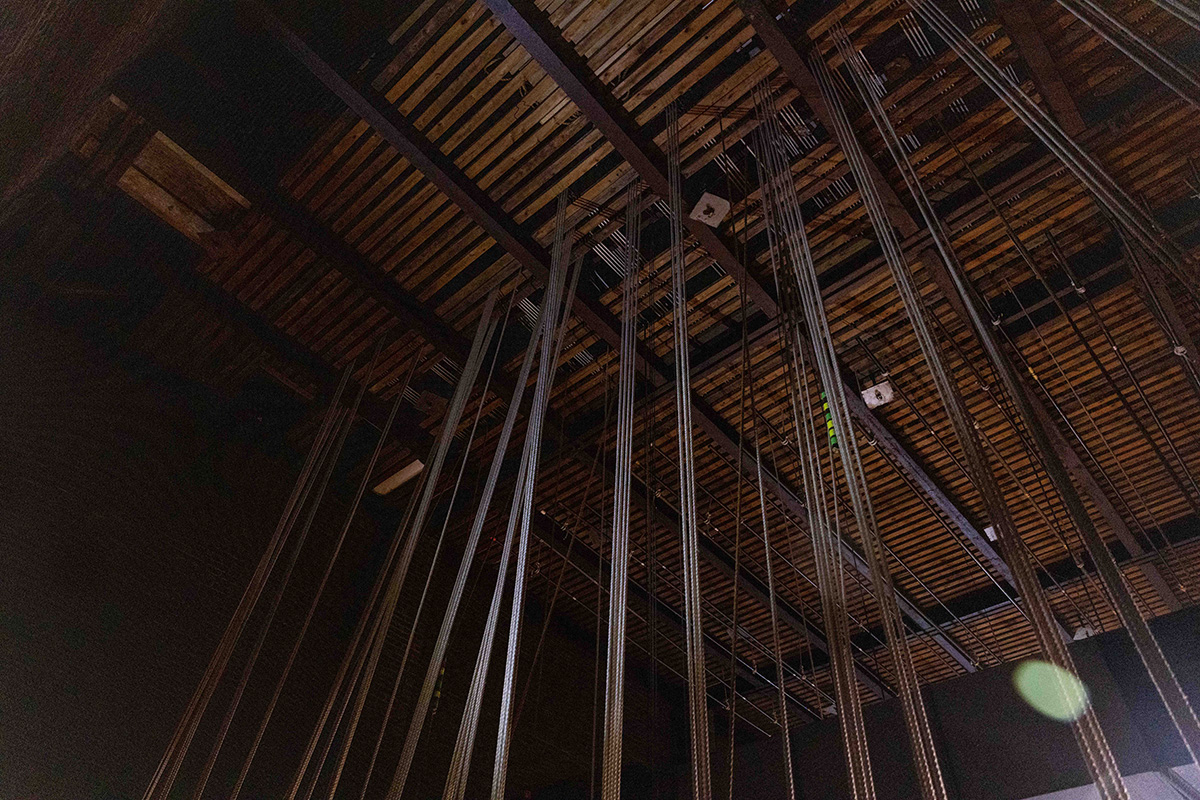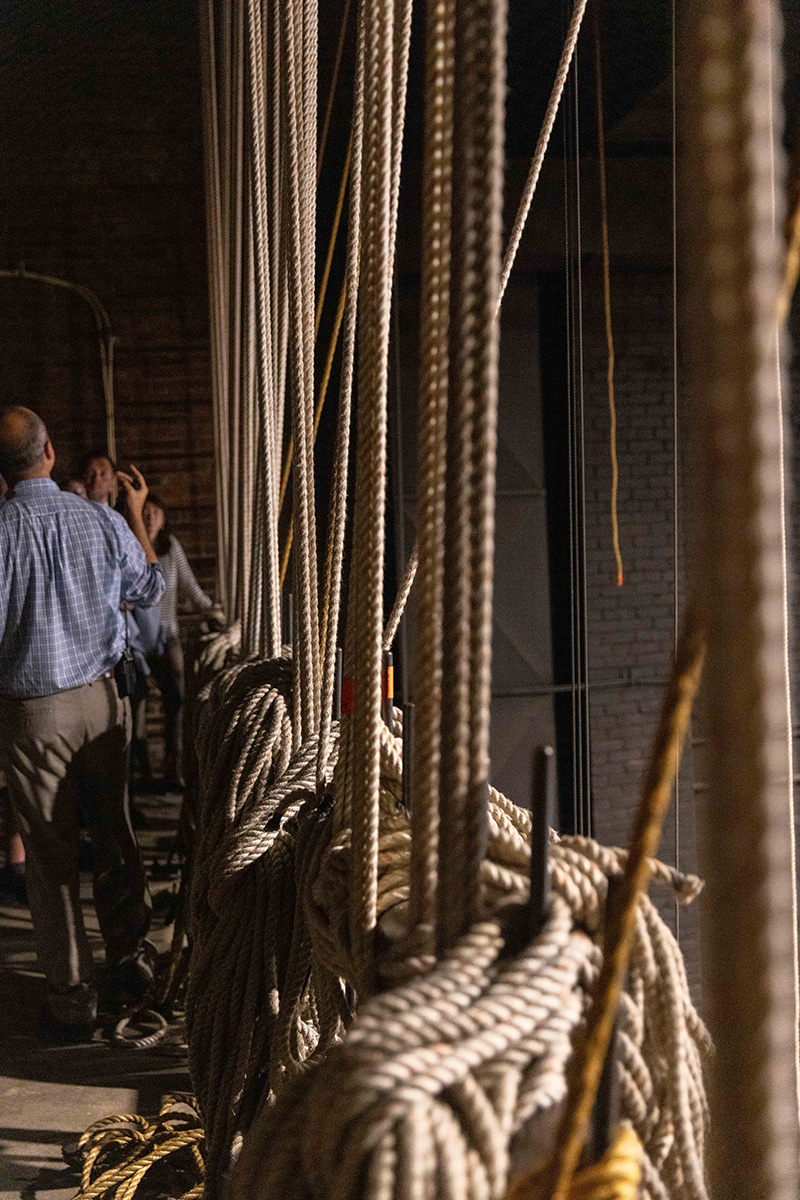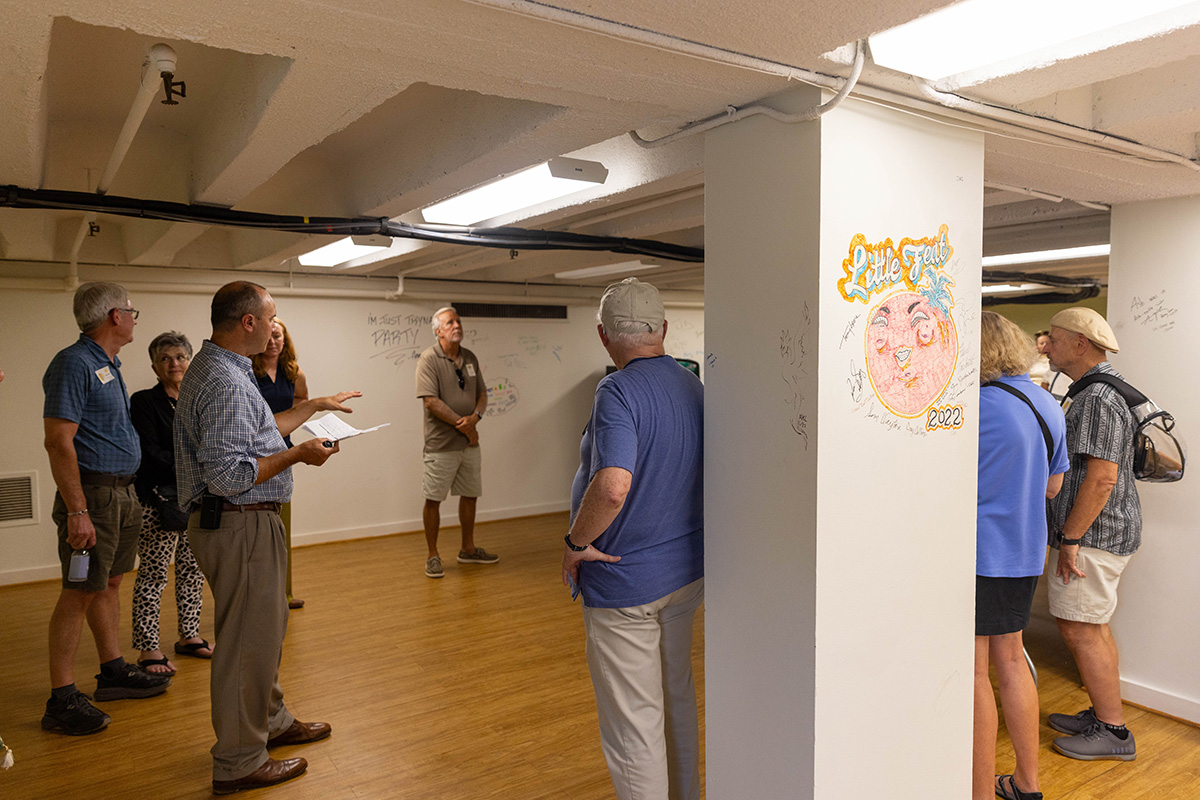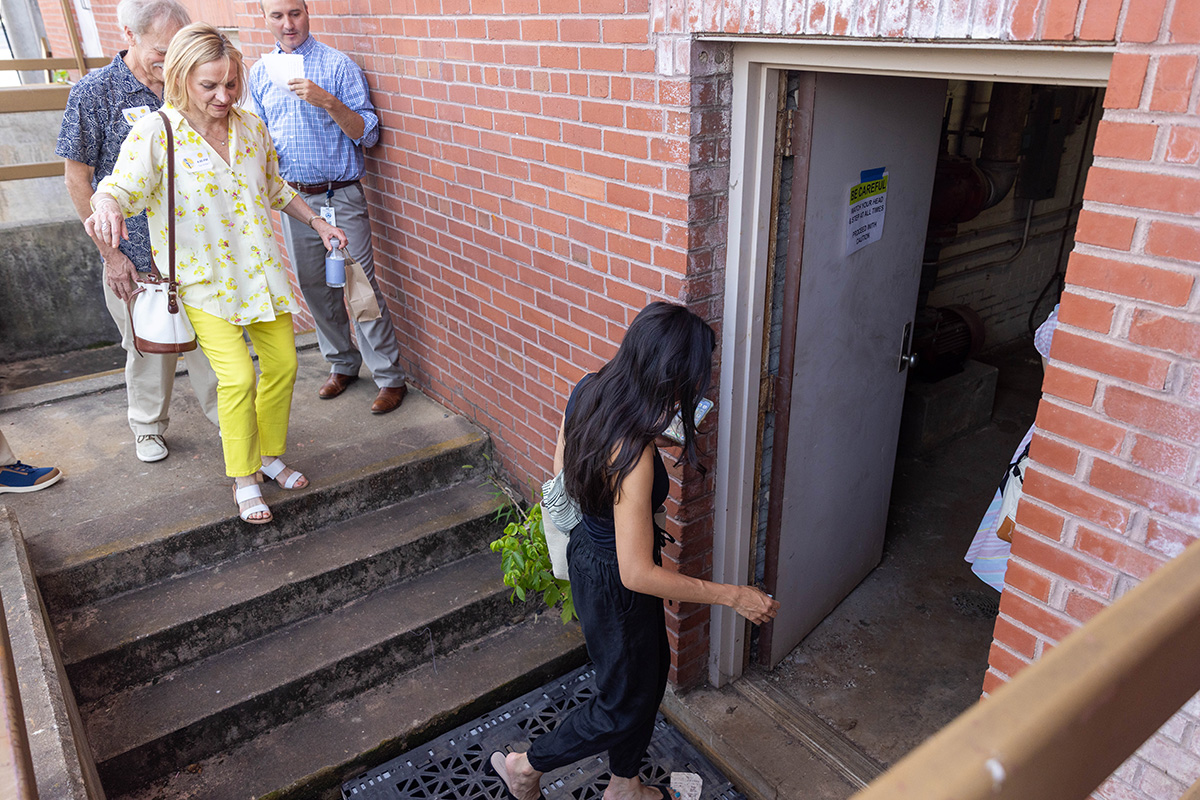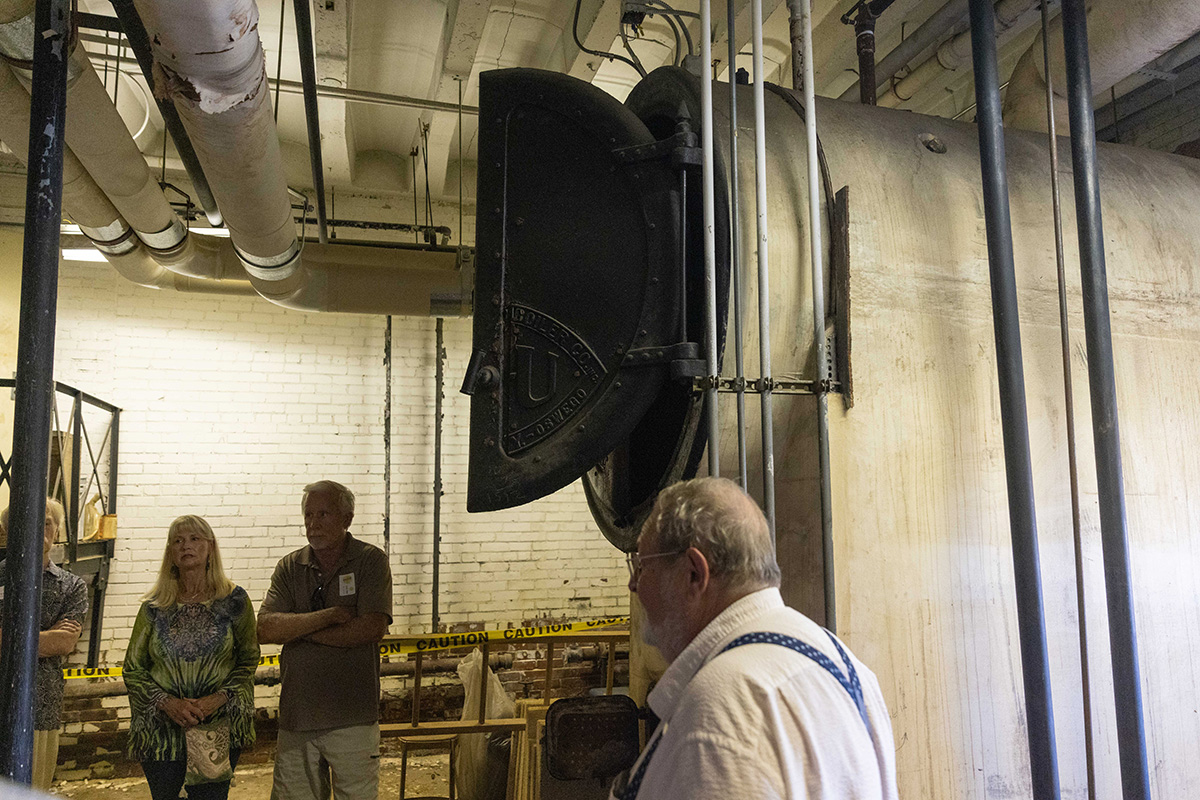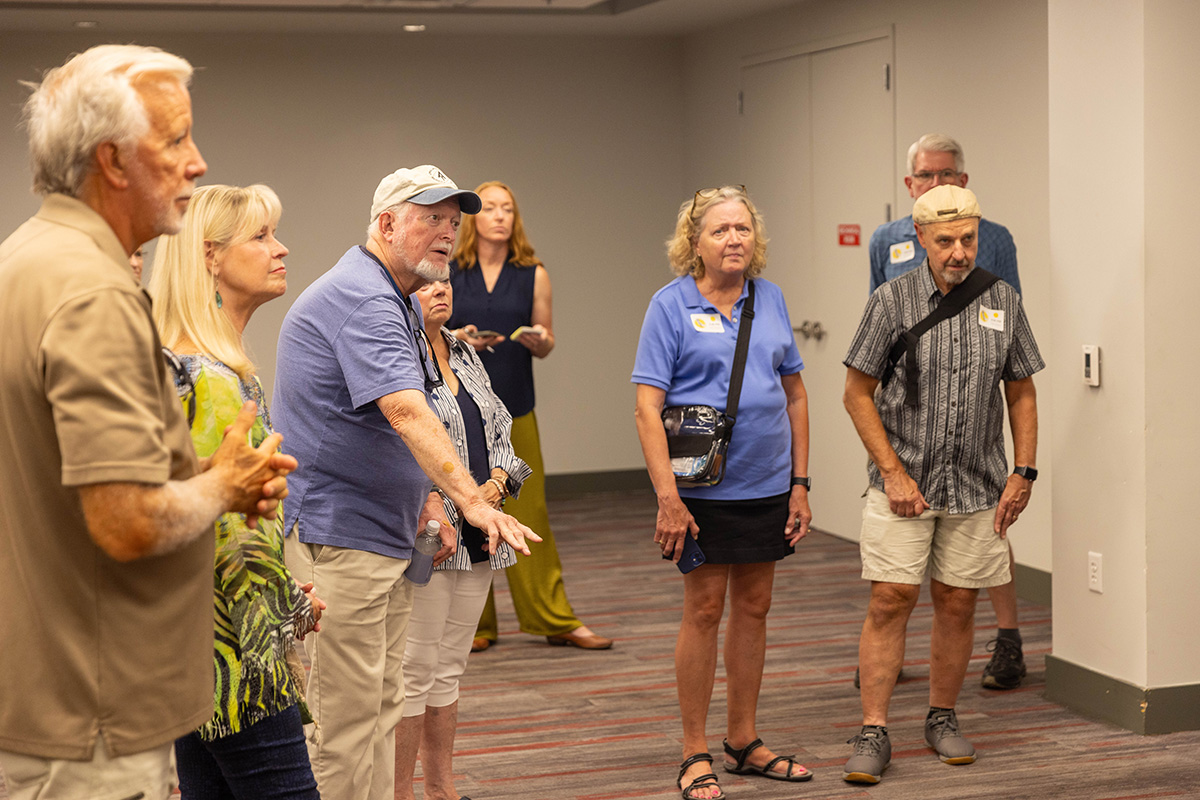
L to R: Katie Cornell, ArtsAVL Executive Director; Vic Isley, President and CEO of Explore Asheville and the BCDTA; Daniel Crupi, Asheville Symphony Executive Director; Robert Long, Conceptual Planner for Theatre Consultants Collaborative; Stephanie Monson Dahl, Planning and Urban Design Director for the City of Asheville; Mayor Esther Manheimer; and Chris Corl, Director of Community and Regional Entertainment Facilities. Photo Credit: Emmanuel Figaro
The Path Forward for Thomas Wolfe Auditorium
Mounting maintenance needs and massive operational failures underscore the urgency of acting to renovate Asheville’s largest performing arts center
by Ali McGhee
August 22, 2023 | Asheville N.C – On July 5, Thomas Wolfe Auditorium closed its doors due to a massive failure of the HVAC system. In the short-term, that failure immediately resulted in scheduled shows being shifted to the ExploreAsheville.com Arena or other locations. In the longer-term, the closure of Thomas Wolfe, even if it reopens in a limited capacity, is estimated to result in a loss of over $20 million for Asheville businesses.
ArtsAVL’s first Town Hall of 2023-24, focused on the current state and future paths forward for the performing arts center, featured behind-the-scenes tours of the closed auditorium, and a panel comprising Mayor Esther Manheimer; Chris Corl, Director of Community and Regional Entertainment Facilities for the City of Asheville; Stephanie Monson Dahl, Planning and Urban Design Director; Vic Isley, President and CEO of Explore Asheville and the Buncombe County Tourism Development Authority; Daniel Crupi, Executive Director of the Asheville Symphony; and Robert Long, Conceptual Planner for Theatre Consultants Collaborative. The panel and Q&A were moderated by ArtsAVL Executive Director Katie Cornell.
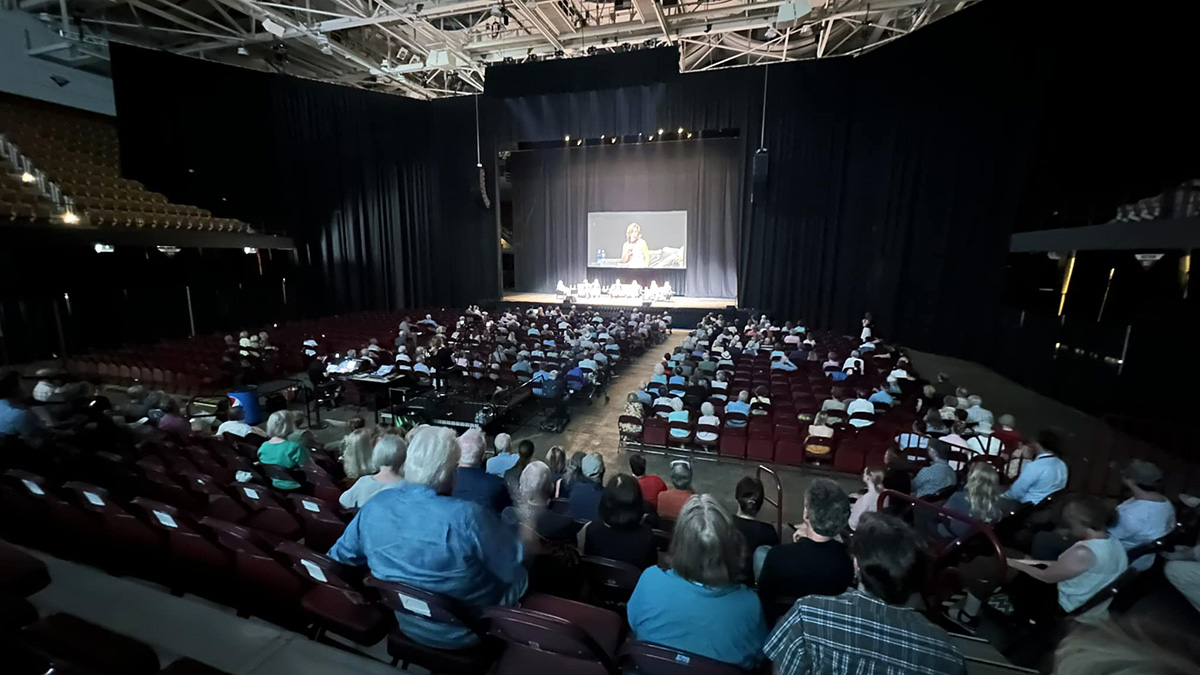
Photo Credit: Andrew Fletcher
At the event, the City of Asheville presented options for major shifts to the auditorium, including five multi-million dollar redesign options, as well as a possible path forward that could incorporate major renovations into the Haywood-Page Revisioning Plan. The first course of action: reopening Thomas Wolfe at reduced capacity for non-ticketed events as early as October.
“ArtsAVL is the designated arts agency from Buncombe County and lead advocate for the arts in our community,” said ArtsAVL Executive Director Katie Cornell. “We will continue to champion issues, like the renovation of Thomas Wolfe Auditorium, that have a major impact on the arts in our area.” ArtsAVL will share more about this and other issues impacting the creative sector at the State of the Arts Brunch on Monday, October 30 from 10:30 a.m.-12 p.m. Tickets are available now.
A historic performing arts center
In 1902, City Auditorium, a “hall of accommodations and large assemblies” was built by the Asheville Auditorium Company. It burned down the following year. Next came the Municipal Auditorium, which opened in 1904, but was condemned in 1931 and finally demolished in 1937 due to safety issues. In 1940, Asheville Auditorium opened its doors. This third iteration of a performing arts center opened with a 3,000-person capacity and was considered one of the greatest Art Deco buildings of its era.
The bones of that building were incorporated into the Asheville Civic Center, which opened in 1974 with four resident arts organizations: the Civic Arts Council (now ArtsAVL), Asheville Art Museum, the Colburn Earth Science Museum (now Asheville Museum of Science), and the Asheville Symphony. Opening night at the newly-named Thomas Wolfe Auditorium featured performances of “Christmas Concerto” and “The Nutcracker” by the Asheville Symphony.
The 1970s were the last time the auditorium had any major renovations. In 2010, the Civic Center became the U.S. Cellular Center, and Thomas Wolfe got a few needed upgrades, including an expansion of the lobby. At the end of 2019, the entire facility became Harrah’s Cherokee Center – Asheville, after the City of Asheville accepted Harrah’s Cherokee Casino’s $5.75 million naming rights bid. The 10-year deal includes $5 million for the naming rights license, $500,000 for fan experience improvements, and $250,000 toward brand change expenses. So far, $2,250,000 of that money has been spent, the majority of it for the arena. $750,000 of the amount was earmarked for renovations at Thomas Wolfe, but necessary major renovations will cost much more – and are increasing in price.
In 2020, the Civic Center Commission’s Thomas Wolfe Auditorium Task Force proposed a $100 million redesign that would have transformed Thomas Wolfe. The proposed renovations included major upgrades to the acoustics, aesthetics, and layout of the space, allowing Broadway performances and significantly enhancing audience experience.

Broadway/Major Renovation and Expansion rendering provided by ESa
Shortly after the first informational sessions were held, the Covid-19 pandemic shut the city down.
Since then, ongoing improvements and maintenance have mostly been in reaction to issues as they occur, and have not addressed the major issues at Thomas Wolfe Auditorium. In May, the main HVAC unit in the auditorium, located in the attic, failed. During a sold-out performance on July 3, the remaining two units experienced belt and coil failures trying to overcompensate, rendering the space unusable. The facility announced its closure on July 5.
“The stakes are very high”
Even before the HVAC failure, the Asheville Symphony heard complaints from patrons. “I’m on the development committee, and when we call donors or attendees and find out why they aren’t coming back next year, so many people mention it’s just Thomas Wolfe Auditorium,” shared Asheville Symphony Executive Director Daniel Crupi in an interview before the panel. He noted that he is not speaking on behalf of the Symphony, which has not released an official position on the auditorium at this time. “So many people out there want to attend the symphony and other events – and would attend if Thomas Wolfe were renovated. The intermission line for the women’s restroom is crazy. People don’t like to look up and see peeling paint. It’s not right for guest artists to have things drop on them.”
The only access point for the auditorium’s attic HVAC, the largest unit. No regional company is willing to work in the space.
He continued: “It’s a lawsuit waiting to happen. Something could go seriously wrong.” He notes major safety issues, including the lack of handrails that create fall hazards. Acoustically, the space also leaves much to be desired, he shared. “Musicians can’t hear themselves play.”
“I think it’s important that we’re the only major city in North Carolina that doesn’t have a [functional] performing arts center of 1,000 seats or more, and it’s embarrassing,” he said.
On the panel, Crupi went even further, calling the state of Thomas Wolfe Auditorium “an existential crisis” that will affect not only the Symphony’s ability to perform and hire musicians, but will impact their community and educational programming outside of performances in the space.
A plan to reopen
Any event currently on Harrah Cherokee Center’s website, regardless of the room it’s in, is still happening, shares Chris Corl, the Director of Community and Regional Entertainment Facilities for the City of Asheville. Many shows have been moved to the ExploreAsheville.com Arena, where comparable seats will be assigned. Thomas Wolfe Auditorium will also reopen in late October or early November in a reduced capacity – six months faster than the initial estimate. At the City’s Planning and Economic Development Committee meeting on August 14, Corl noted that $200,000 from Harrah’s Cherokee Center – Asheville’s appropriated fund balance (a “rainy day fund”) can be used to repair the HVAC system.
In the Town Hall, Corl sketched out that there are three units in the auditorium. The main unit, in the middle of the auditorium’s attic, has historically provided 55-60% of the space’s heating and cooling. The attic dates to the 1930s and does not meet current safety standards, which would require the addition of a catwalk and a fall arrest system. Because no regional companies are willing to work in the space, Corl and his team have proposed abandoning the unit and revisiting the safety additions later.
The remaining two units – on the back balcony (which historically provided 30% of the heating and cooling) and stage (which provided 15%) – will have their ductwork melded together using the main unit as a connection point. “These two units will provide air movement, heating, and cooling for the entire space, but will require a slightly lower capacity,” shared Corl. That reduced capacity is estimated to be between 1,000 and 1,500 people between September and May, and as low as 500 during June, July, and August due to high temperatures outside. The auditorium should reopen this fall for reduced capacity and for non-ticketed events, such as community speaking engagements, award ceremonies, private events, and amateur dance and cheerleading competitions. The Asheville Symphony will be one exception – Corl notes that because they are local and understand the situation (versus an out-of-area promoter), they will be invited back into the room to host ticketed performances if they desire.
From there, Corl and his team will support planning for the space. Ultimately, the city will have to decide whether to focus on a large-scale renovation or smaller upgrades.
One of the options: updating the attic and repairing the main HVAC at a price point of about $1.2 million. In the Planning and Economic Development meeting earlier this month, Corl noted that this path “would get us back to May, when we were one month away from getting shut down.”
Even if the HVAC system is repaired for the longer-term, Corl shared, a mounting pile of other maintenance needs may shut the auditorium down again. He noted that over the past eight years, a running total of $2.17 million has been spent on repairs and small enhancements – at the auditorium. He pointed out that other issues are imminent, including with the electrical system (much of the space is on a fuse box that requires glass fuses, which are no longer in production and must be special ordered from Ebay).
The longer-term solution
City leadership recognizes the vital importance of the Auditorium to the area. Mayor Manheimer emphasized its critical role not only for the arts, but for all of downtown, which has seen a recent drop in tourism and revenue. “Spectacular things make spectacular cities,” said Mayor Manheimer. “This could be a space that infects – in a positive way – an entire downtown, and encourages people to want to be, work, and live there.”
Monson Dahl added that the City’s Public Art Master Plan describes Asheville itself as “a work of art,” and that the Downtown Master Plan calls downtown the city’s “front porch.”
“This is a place for community,” she said, noting that she was speaking for herself rather than representing an official position. “We need to have facilities downtown that match our vision.”
Beginning in 2012, teams have done nine separate studies of the auditorium, all of which Asheville leadership will review and compare. Corl used these studies and collaborated with Nashville-based design firm ESa (Earl Swensson Associates), who worked on the 2020 redesign, to come up with a menu of various options and price points that he presented at the Town Hall. Numbers are based on 2028 estimates – the projected date for when renovations might actually begin. The options outlined are:
Option 3
Improved raked floor arrangement, similar to the current setup but more functional and with improved sightlines – $105-$125 million
Option 4
Multi-purpose flat floor arrangement (similar to Charlotte’s Fillmore) that would allow for diverse programming – $90-$110 million
While all figures but Option 5 exceed 2019’s estimate for a major renovation, quoted before pandemic-related supply chain shortages and price increases, there is an argument to be made that the high cost would be recouped within a few years. Greensboro, North Carolina’s Tanger Center, which cost $94 million and opened in 2022, covered its annual $2.2 million in debt repayment in its first 10 months open and generated “tens of millions in economic impact,” according to the Greensboro News and Record.
Once finances are agreed on, “we could design and build to that budget,” said Corl.
Corl also expressed the importance of public engagement in the process. “What does Asheville want the future of Thomas Wolfe to be?” he asked during the Town Hall. “There was a lot of stakeholder engagement pre-Covid, and there has been nothing post. It’s an opportunity to see if the same desires are out there as pre-pandemic, or if they’ve shifted.”
Larger-scale renovations to the auditorium could include additions like black box space for rehearsals or smaller performances, which would enable more organizations to take advantage of the space. Currently, the Asheville Symphony is the only local organization that regularly programs the auditorium.
Addressing a question about the possibility of constructing a new performing arts center elsewhere in the city, Mayor Manheimer shared that the possibility was highly unlikely at this time, and that the City’s interest is in renovating Thomas Wolfe. “As a body, Council has voiced a strong concern for maintaining and renovating city-owned assets, of which this is one,” she explained.
Corl noted that the cost of a brand new build would be approximately $135 million for 100,000 square feet (the average size of a large performing arts center), not including the cost of the land or construction of a parking deck, the cost of which Mayor Manheimer noted was “astronomical.”
Funding the way forward
McCormick Field provides a blueprint Asheville could use to renovate the auditorium. The $37.5 million renovation, which included funding from the City of Asheville, Buncombe County, the Asheville Tourists, and $22.9 million from the Buncombe County Tourism Development Authority, was approved in July.
The Thomas Wolfe Auditorium would cost significantly more, but the precedent exists now, noted Manheimer. She also mentioned a possible bond referendum, but noted that similar referendums in other communities, like Greensboro, failed, and that “pulling together a partnership” the way stakeholders did with McCormick Field might have a better chance of success, though it will require multiple community partners and debt financing, as the TDA is doing with the baseball stadium.
Continuing to develop the Haywood/Page Master Plan and incorporating a renovated Thomas Wolfe into that is another way that diverse community partners could support the space, said Monson Dahl.
Funding could also come from sources such as naming rights for the auditorium or other spaces within the complex, including the banquet hall and lobbies. Corl noted that the auditorium was named in the 1970s, and has had three other names since 1902.
Manheimer shared that Council is hoping to make decisions quickly. Whatever path is selected, Long, who has worked as a consultant on conceptual redesigns for the auditorium for two decades, pointed out that construction costs will only continue to rise.
At the end of the discussion, each panelist reflected on the critical importance of Thomas Wolfe.
“Projects like this one serve as anchors in the virtuous cycle of driving visitors and the local economy,” said Isley. “Visitors contribute to lodging tax and pay for goods and services. That helps fund new projects and supports projects throughout the city and county. That said, Thomas Wolfe is owned by the City. It needs to be the City’s priority to approach the Authority to make an investment in Thomas Wolfe to support our community and economy. We are thrilled by possibilities of working together. There are more opportunities to win when we are all pulling in the same direction. This is a chance to do that.”
She continued, “The back of the house is called the heart of the house. And the heart of this house is really strong. It just needs an extreme makeover.”
ArtsAVL will continue to report on Thomas Wolfe Auditorium as discussions evolve. Until then, people can support the conversation by submitting feedback at here. You can support the Asheville Symphony by attending Symphony in the Park on Sunday, Aug. 27 from 7-9 p.m. Tickets are also on sale now for the State of the Arts Brunch.

